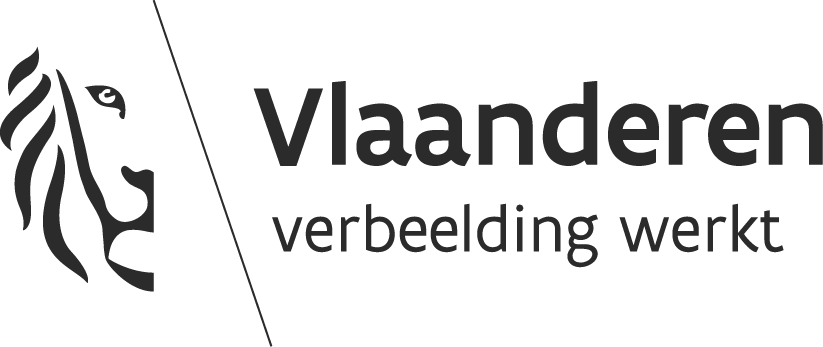Welcome to Publiek Park in Plantentuin Meise!
June 27 - September 28, 2025
In the summer of 2025, Publiek Park returns with the third edition of the nomadic contemporary art project, exploring urban parks and gardens as exhibition sites. This iteration invites visitors to travel through both time and space, as it evolves in two chapters – moving from Plantentuin Meise to Jardin Botanique de Bruxelles, from the current to the original site of the botanic garden.
The exhibition brings together works by eleven international and local artists, each showcasing two artworks: one in Meise, and one in Brussels; one newly commissioned, and one existing. As these two gardens offer distinct perspectives on the role of green space and horticulture in contemporary urban life, their contexts allow for different aspects of the artists’ practices to come into focus. While the exhibition at Plantentuin Meise consists of more permanent, static installations on view for three months, the chapter at Jardin Botanique centres on ephemeral, time-based works unfolding over eleven days in September.
The trail of eleven artistic interventions in Plantentuin Meise guides visitors through a spectrum of narratives: from gardens as architectural-administrative complexes that classify and contain nature, to reflections on plants as commodities within global trade networks. Along the way, it invites encounters with species’ co-evolution, imagined hybrid beings, and flora whose histories intertwine with personal stories of migration and colonialism. These works extend into imaginative narratives – drawing from medicinal, technological, and scientific knowledge, indigenous traditions, linguistic lapses, intimate memories and science fictions.
With site-sensitivity as a guiding ethos, Publiek Park invites artists to engage with the specific textures of the public green spaces – their shifting ecologies, architectural traces, and layered histories. The project unfolds as a walking route through the residues of history into futures not yet mapped, from botanical research to reflections on contemporary life.
The exhibition is curated by Jef Declercq, Anna Laganovska, Koi Persyn and Adriënne van der Werf, assisted by Lana Jones, Alise Pētersone and Jean Watt.
Publiek Park 2025 is created in collaboration with CC Strombeek, Plantentuin Meise, Botanique, Brussels Environment, Wiels, Art Cinema OFFoff, TRACK, Level Five, LUCA School of Arts, 019 and more.
The project is generously supported by the Flemish Government, Embassy of the Kingdom of the Netherlands, Mondriaan Fonds, French Embassy in Belgium, Institut français, the State Culture Capital Foundation of Latvia (VKKF), Federal Ministry Republic of Austria (BMKÖS), Flemish Community Commission (VGC), Pro Helvetia, Servais Family Collection, Harlan Levey Projects, Gauli Zitter, Nesse and others.
The exhibition brings together works by eleven international and local artists, each showcasing two artworks: one in Meise, and one in Brussels; one newly commissioned, and one existing. As these two gardens offer distinct perspectives on the role of green space and horticulture in contemporary urban life, their contexts allow for different aspects of the artists’ practices to come into focus. While the exhibition at Plantentuin Meise consists of more permanent, static installations on view for three months, the chapter at Jardin Botanique centres on ephemeral, time-based works unfolding over eleven days in September.
The trail of eleven artistic interventions in Plantentuin Meise guides visitors through a spectrum of narratives: from gardens as architectural-administrative complexes that classify and contain nature, to reflections on plants as commodities within global trade networks. Along the way, it invites encounters with species’ co-evolution, imagined hybrid beings, and flora whose histories intertwine with personal stories of migration and colonialism. These works extend into imaginative narratives – drawing from medicinal, technological, and scientific knowledge, indigenous traditions, linguistic lapses, intimate memories and science fictions.
With site-sensitivity as a guiding ethos, Publiek Park invites artists to engage with the specific textures of the public green spaces – their shifting ecologies, architectural traces, and layered histories. The project unfolds as a walking route through the residues of history into futures not yet mapped, from botanical research to reflections on contemporary life.
The exhibition is curated by Jef Declercq, Anna Laganovska, Koi Persyn and Adriënne van der Werf, assisted by Lana Jones, Alise Pētersone and Jean Watt.
Publiek Park 2025 is created in collaboration with CC Strombeek, Plantentuin Meise, Botanique, Brussels Environment, Wiels, Art Cinema OFFoff, TRACK, Level Five, LUCA School of Arts, 019 and more.
The project is generously supported by the Flemish Government, Embassy of the Kingdom of the Netherlands, Mondriaan Fonds, French Embassy in Belgium, Institut français, the State Culture Capital Foundation of Latvia (VKKF), Federal Ministry Republic of Austria (BMKÖS), Flemish Community Commission (VGC), Pro Helvetia, Servais Family Collection, Harlan Levey Projects, Gauli Zitter, Nesse and others.
1. Office for Joint Administrative Intelligence
at the HerbariumhuisO.J.A.I. Echo, 2025
Sound installation, modular sounds, spoken words, architectural plan
At Plantentuin Meise, the Office for Joint Administrative Intelligence turns their attention to the garden as an institutional entity, one that processes, contains, and regulates nature through administrative operations. Herbariumhuis, a 1960s modernist office block that manages the garden as a living archive, is seen as an architectural-administrative complex of filing cabinets, drawers, corridors, dead ends, and quiet concrete – a site of classification and containment.
On 27 June, during the opening evening of Publiek Park, a performance titled Institutional Overgrowth takes place at the Herbariumhuis. In a sonic and spoken activation of the building, both O.J.A.I. operatives deliver braided spoken lists: List A (ecological insurgency) and List B (bureaucratic procedures and breakdown). The lists are punctuated by field recordings and speculative sounds: insect pulses, taxonomic shuffles, and architectonic drones. A clipped public announcement repeats at the beginning of the work, annexing the atmosphere into timekeeping, enclosure, and authority: “This building is subject to ongoing procedural oversight. Access beyond the public areas is strictly prohibited.”
Following the performance, the sound installation The Echo reverberates through the building as a haunting residue, suggesting a space ritually marked, procedurally disturbed, and acoustically overgrown. Projected through five tannoy speakers – a sound system typically used for public announcements – fragments of the aforementioned lists, infrastructural hums, and clipped announcements circulate in an endless, categorising loop. The Echo is accompanied by a large printed floor plan, sourced from the archive housed in the Herbariumhuis: part architectural document, part speculative map, annotated with marginalia, procedural markings, and invented spatial categories.


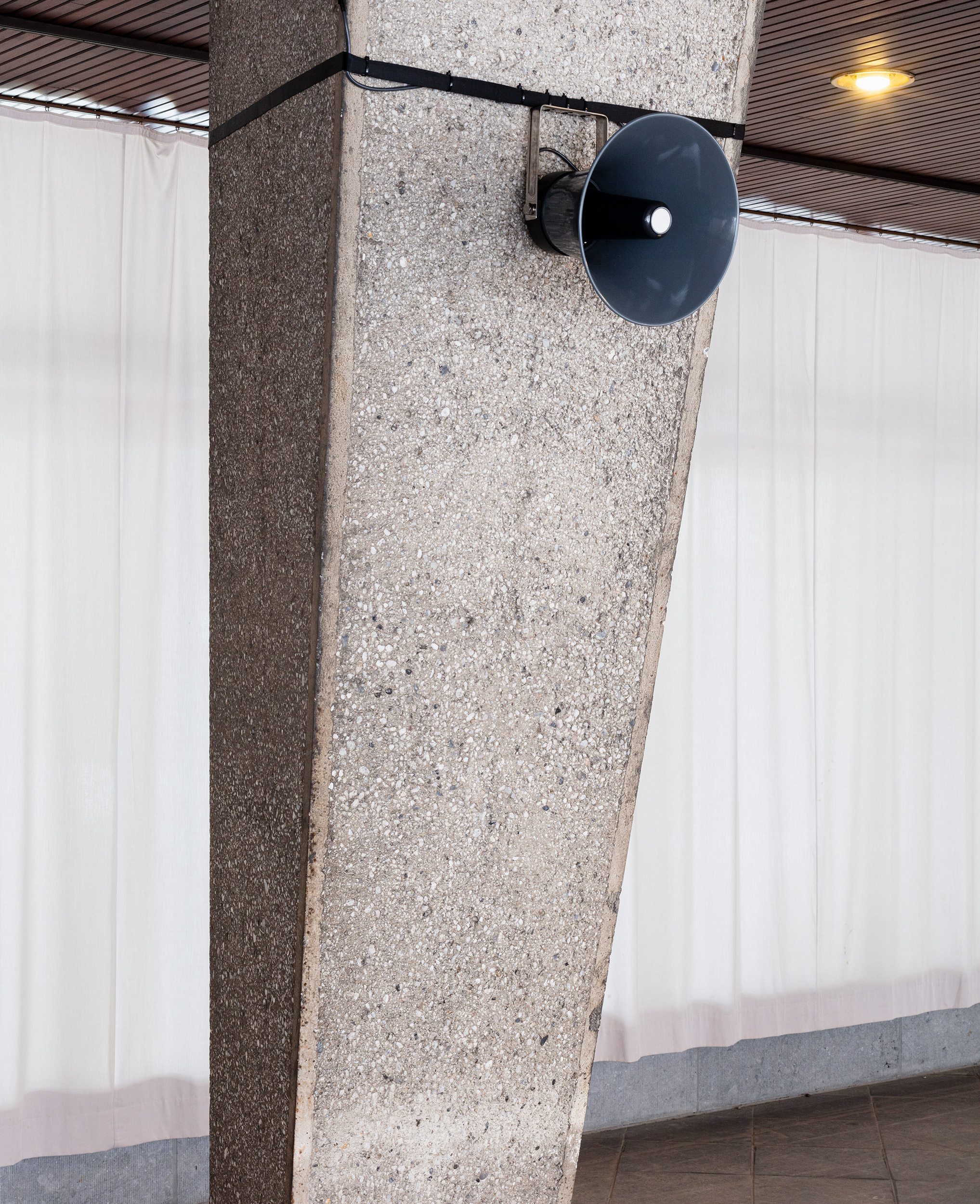
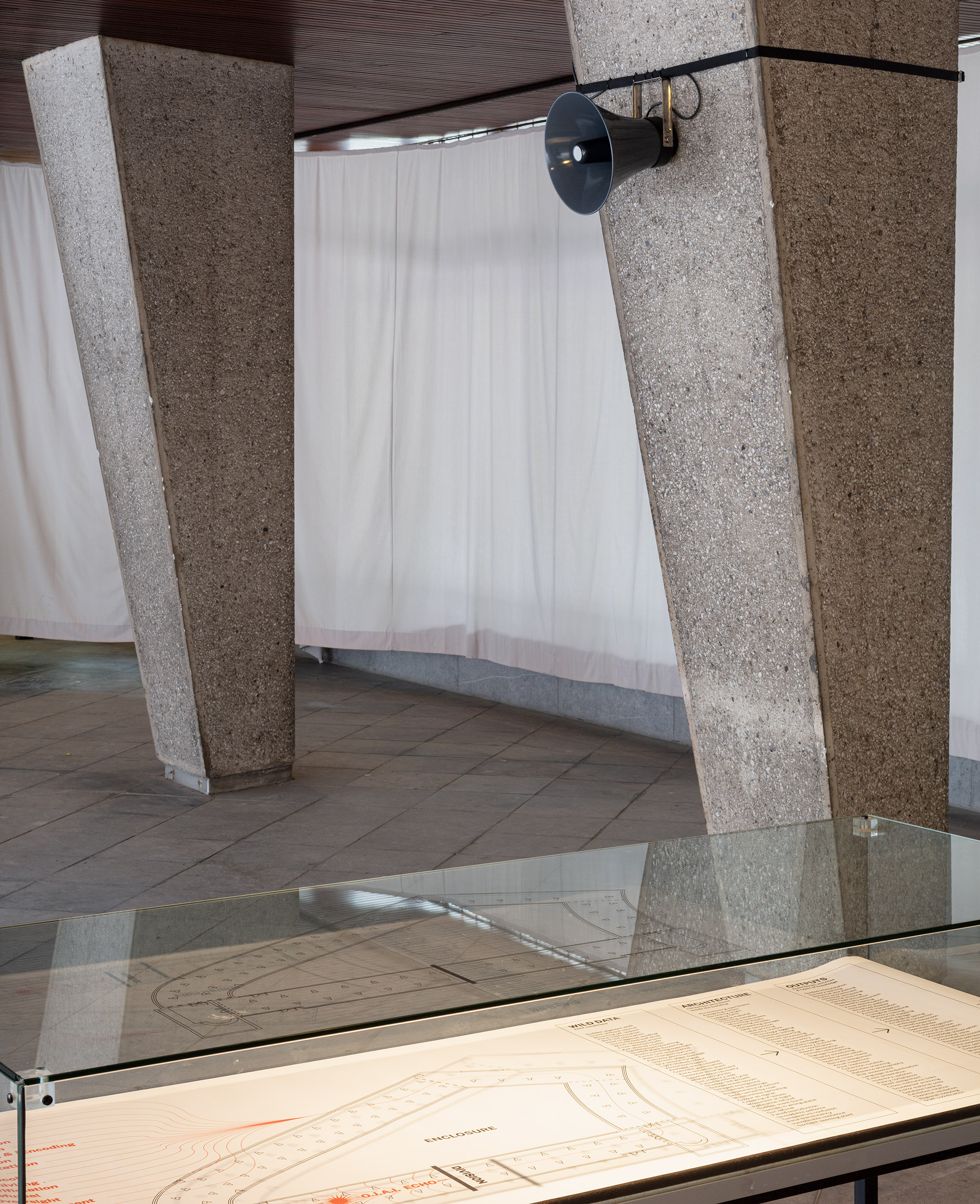



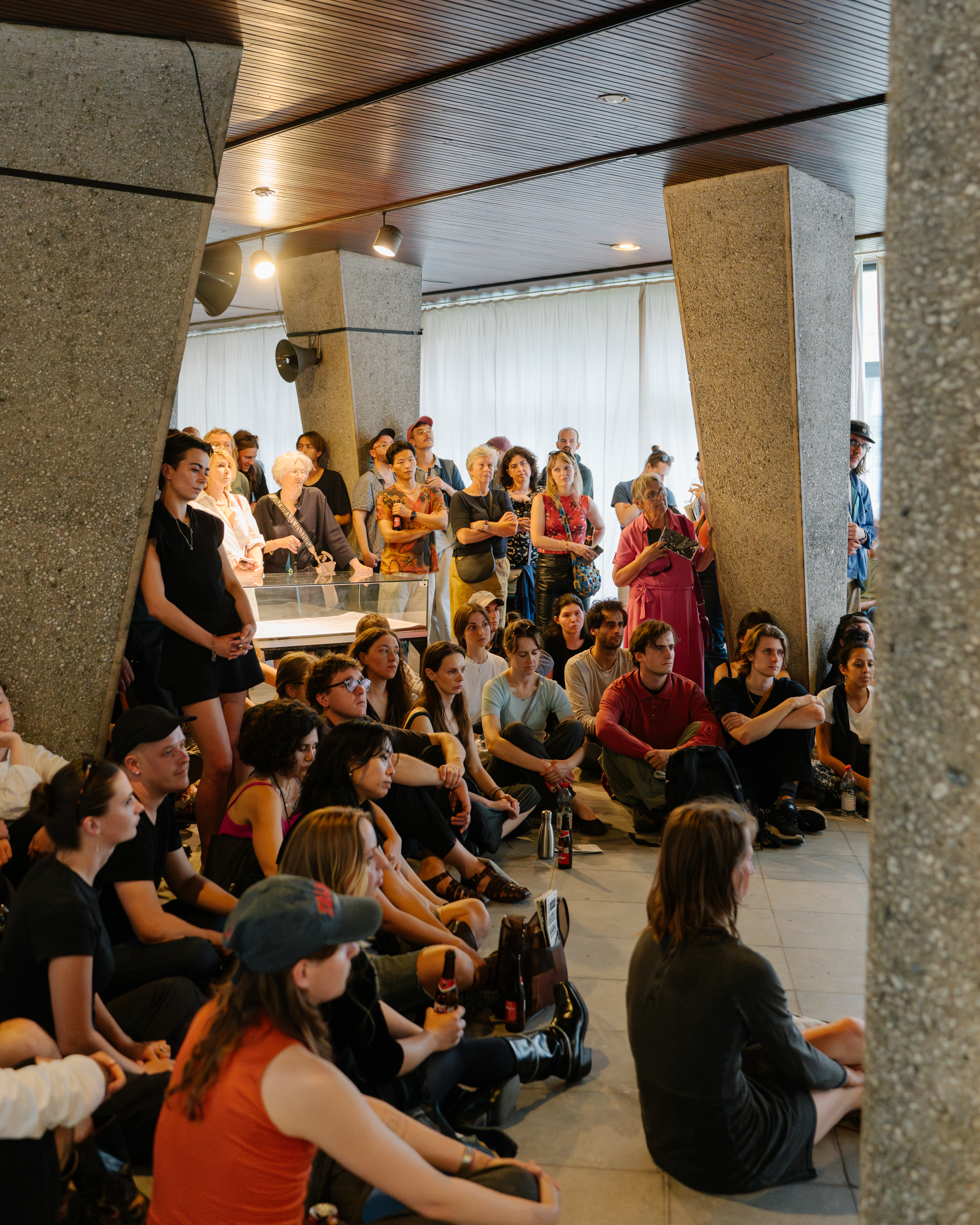
2. Roy Köhnke
at the Green ArkEscap' in(g)to You, Trap series, 2024
Stainless Steel
Evolv' in(g)to You, Trap series, 2024
Stainless Steel
High touch #1, Parade series, 2024
Stainless Steel, fabric
Extreme Softness, Magnetic Tendencies series, 2024
3D video animation, 3’38”
3D : Guillaume Seyller
BO : Talita Otovic, +/+, 2024
Coproduction MO.CO, Montpellier et Fondation des artistes
The Green Ark, the newest architectural addition to Plantentuin Meise, hosts botanical activities focused on preserving biodiversity. In one of its greenhouses – where plants are often stored temporarily – Roy Köhnke presents an installation comprising works from three ongoing series in his practice. Through these works, the artist explores how bodies are constructed – both socially and physically – via encounters with other bodies.
Frame-like structures support two stainless steel sculptures from the Trap series. The sharp steel forms resemble hybrid, biomorphic organisms, as if emerging from an unknown future. Resting atop the support structure are two works from the Parade series, which recall the materiality of camouflage nets. Through this, the forms gesture to ideas of violence and protection, and of plant and insect bodies which can alter their surfaces into visual shields. The fabric also reveals an unexpected softness within the hardness of steel, while the film filters, colours, and fractures the light that passes through it, shimmering in different shades depending on the viewer’s position.
The animation film Extreme Softness, from the Magnetic Tendencies series, refers to the process of co-evolution, in which the morphologies of certain plant and insect species adapt in relation to each other, primarily for reproductive purposes. Such species include orchids and moths, as well as figs and wasps. The installation evokes a subtle ecology of touch, where steel, film, and animation trace relationships across bodies, mapping a delicate choreography of mutual becoming.
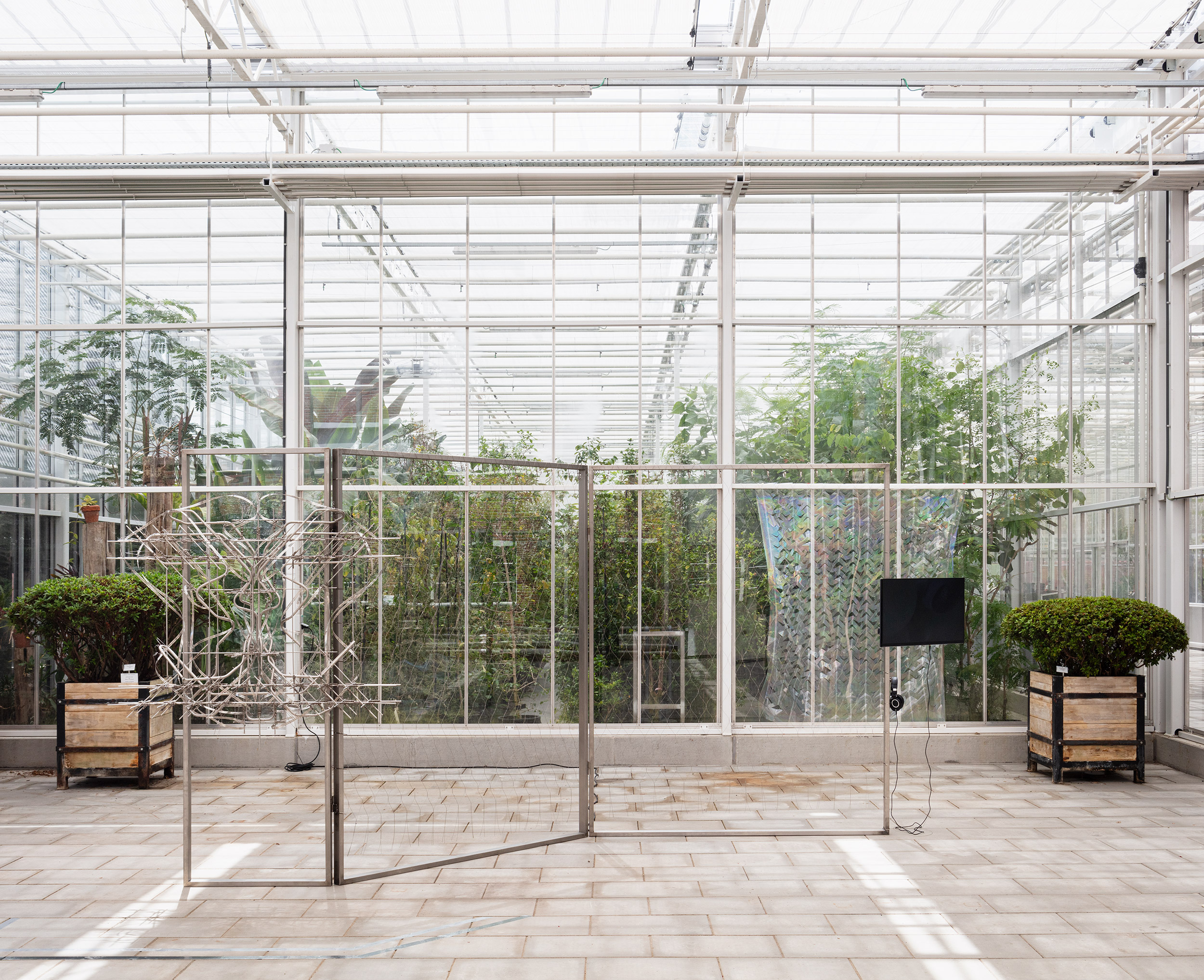


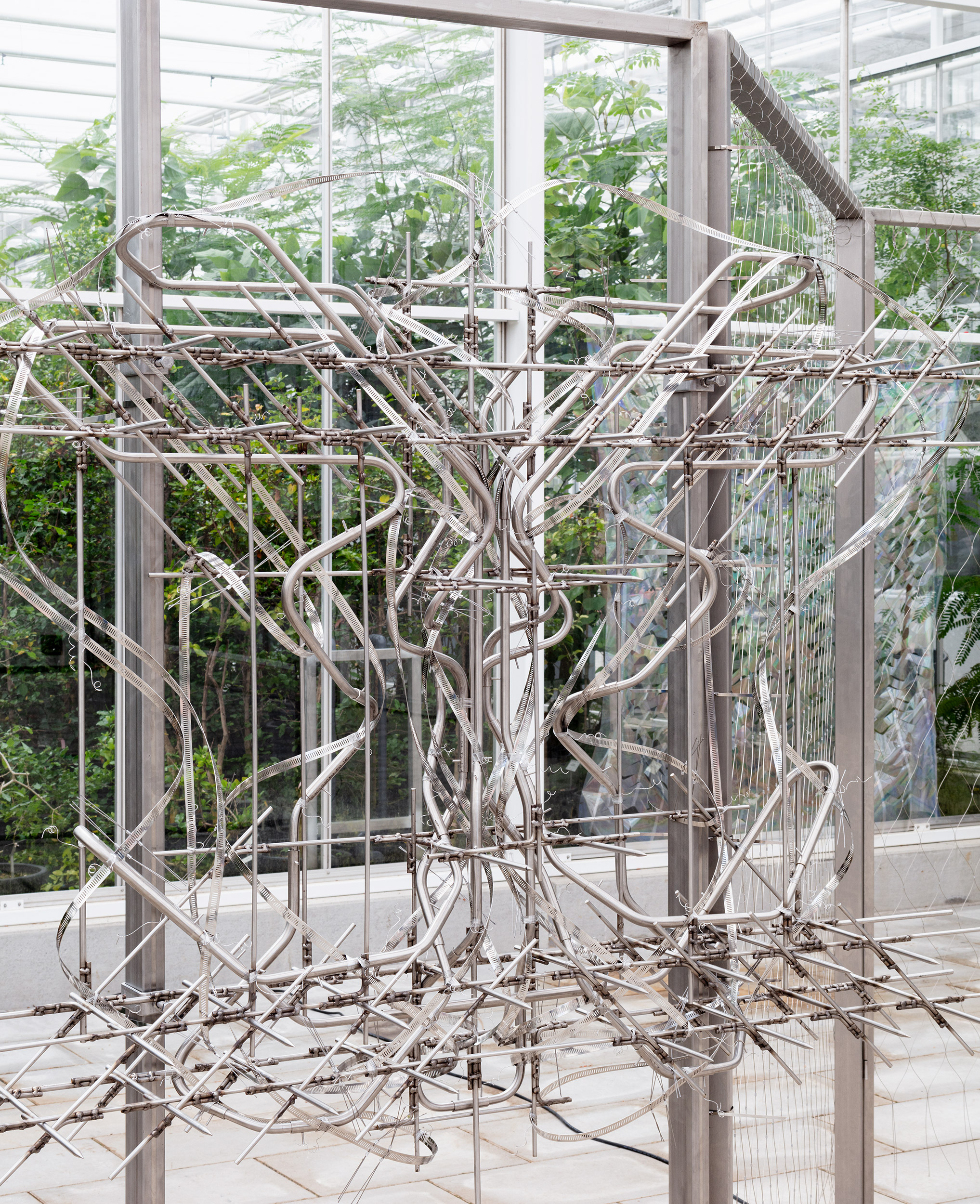

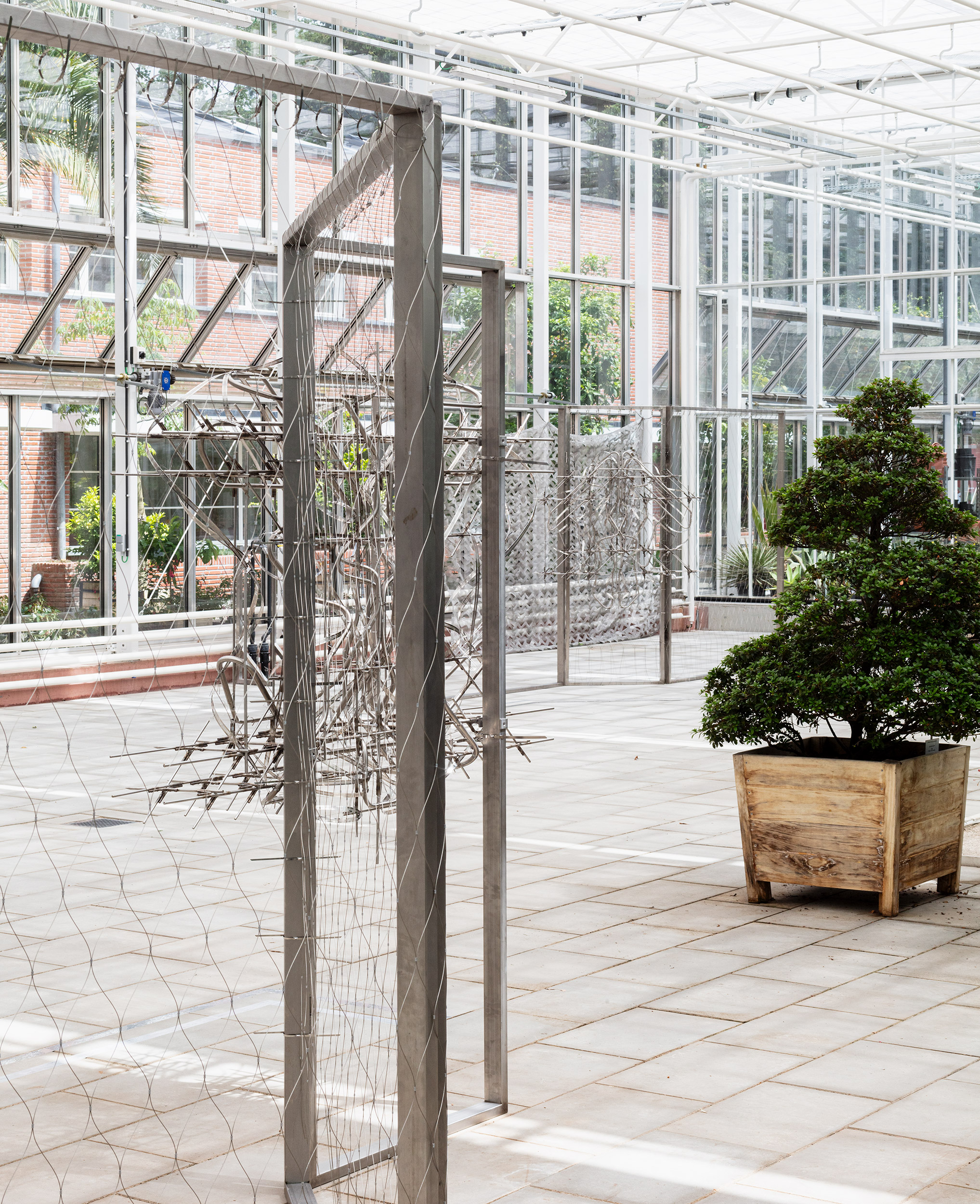


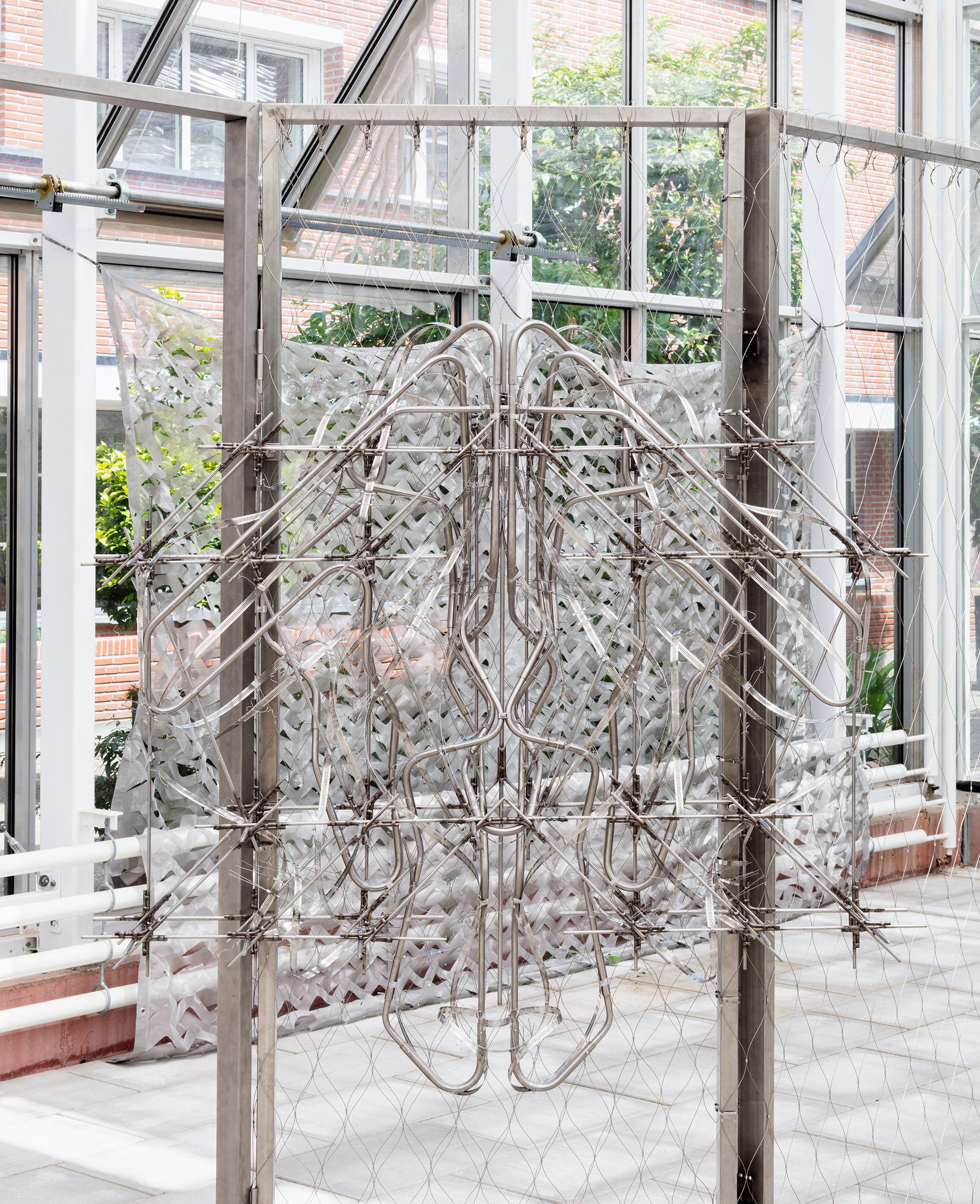


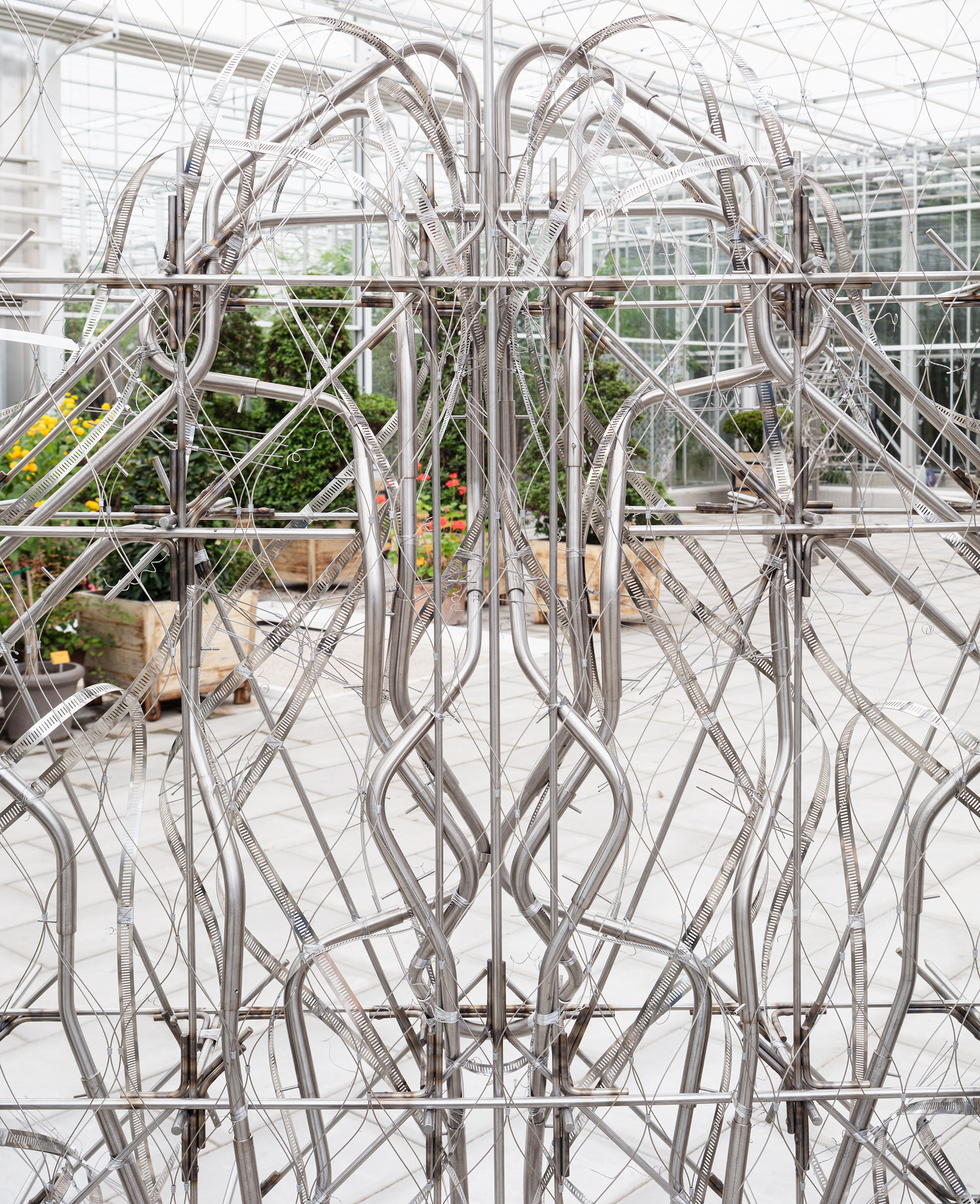
3. Līga Spunde
at the entrance of Plant PalaceEden is exhausted too, 2025
Digital drawing
Placed on both sides of the entrance to the Plant Palace, two banners depict fictional worlds inhabited by mysterious creatures, titled Eden is exhausted too. One of the references for these digital drawings is the work of Hieronymus Bosch, specifically the triptych The Garden of Earthly Delights. Echoing the spatial iconography of an altarpiece, the left and right panels of Bosch’s masterpiece depict the saved and the damned, on each side respectively.
Another key source of inspiration in Līga’s work is the field of cryptozoology, which originated in Belgium with central figures such as Bernard Heuvelmans and Alika Lindbergh. Defined as a pseudoscience and subculture, cryptozoology studies folkloric or extinct animal species whose existence remains disputed or unverified.
The worlds depicted in Spunde’s drawings resonate with the multitude of biomes represented in the vast greenhouse complex, alluding to unidentified and elusive creatures that might dwell within them. Some of these beings appear to have escaped the drawings, dispersed as sculptures across the grounds of Plantentuin Meise. The visitors are invited to discover these creatures on their journey through the botanic garden, following clues encoded in the imagery.




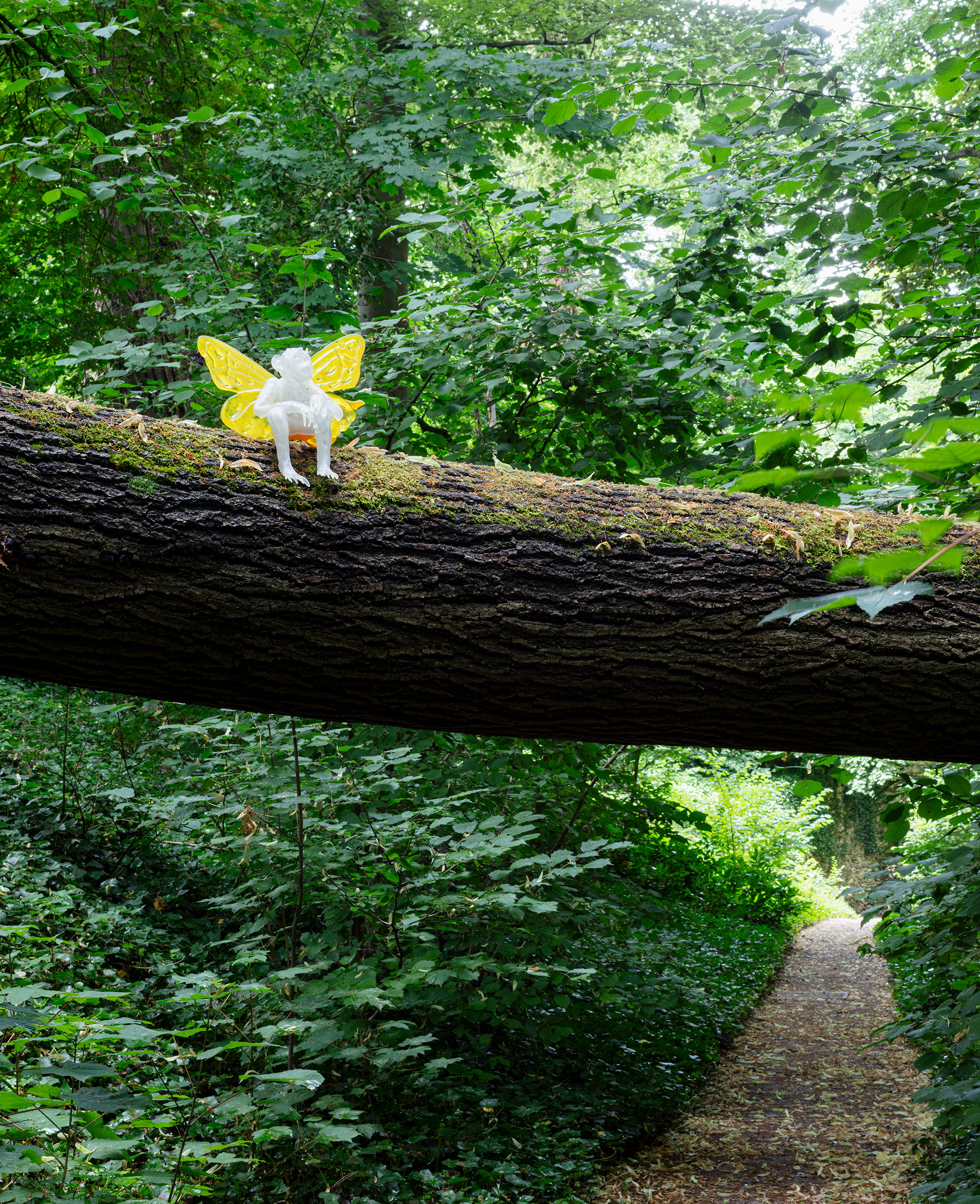



4. Judith Kakon
at the Plant PalaceIris series, 2024/2025
Glazed 3D printed ceramic
The Plant Palace greenhouse complex houses thousands of plant species arranged in biomes – from arid desert to tropical rainforest. Scattered throughout the different climates are works from Judith Kakon’s Iris series. At first glance, these ceramic sculptures resemble the standardised, plastic containers used to transport flowers worldwide. In fact they are produced through 3D printing, carefully hand-glazed in different colours. Sensitive to their environment, the works appear almost incidental at times – modest interventions subtly inserted into the greenhouse setting.
By recalling the stackable pots manufactured for the commercial flower trade, the series of works speaks to the logistical systems that sustain the flower industry and the economic bubbles they have inspired, such as the period of “tulip mania” in the seventeenth-century Netherlands, where prices for bulbs soared to extraordinary levels. Their presence within the Plant Palace emphasises the inherently artificial construction of a botanical garden – where questions of origin and displacement are always at play. Specifically, the histories of containers used to carry plants traces back to the Wardian cases once used by Belgian plant hunters to move species to the botanical gardens from around the world. In this way, Kakon’s forms are embedded with the economic processes of plant circulation and appropriation.
The title of the series, Iris, also situates the works within the geographical context of Belgium, in a serendipitous nod to the emblematic flower of Brussels, which once thrived on the marshy banks of the Senne. Through this, the works become delicately rooted in the locale of the exhibition, while speaking to broader entanglements of botany, commerce, and place.




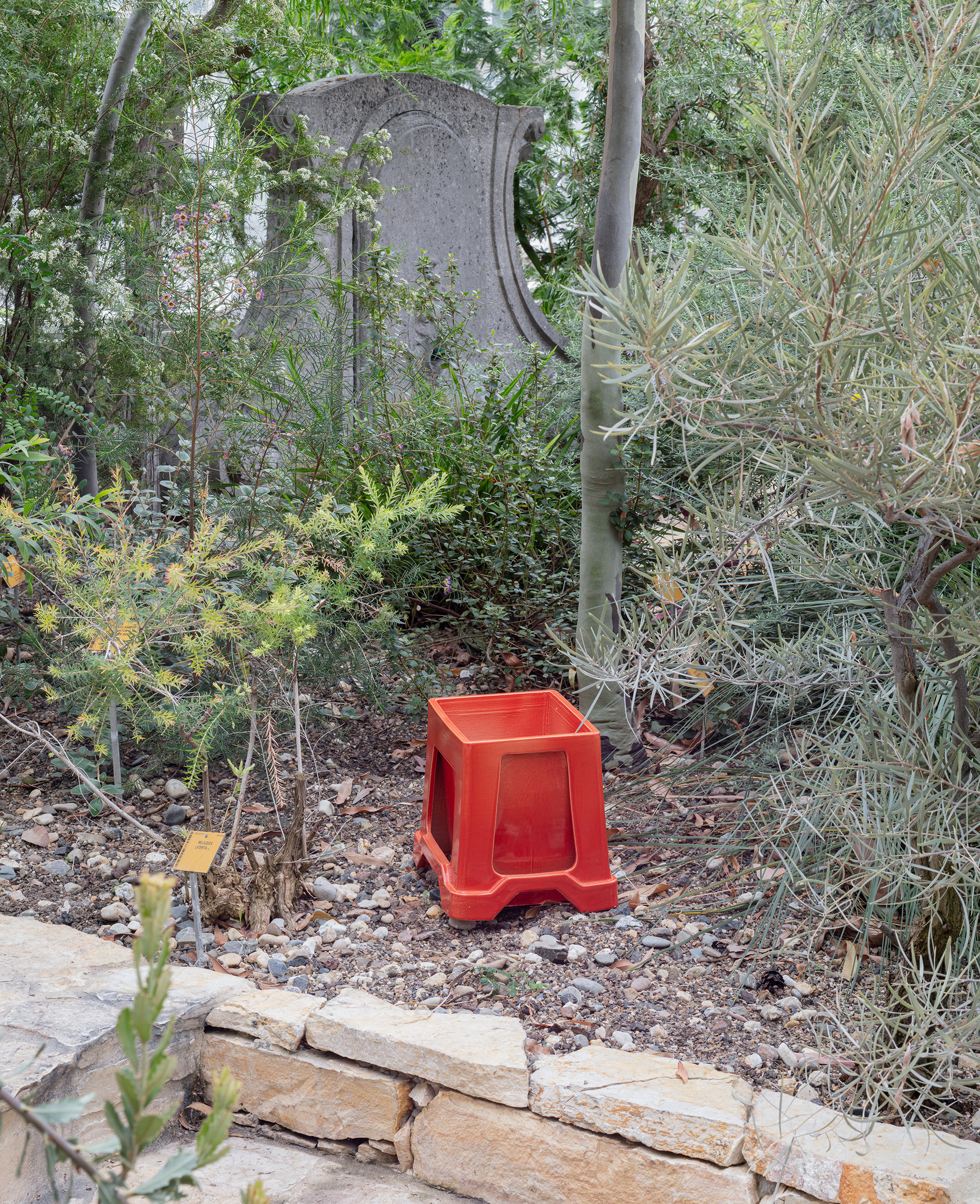

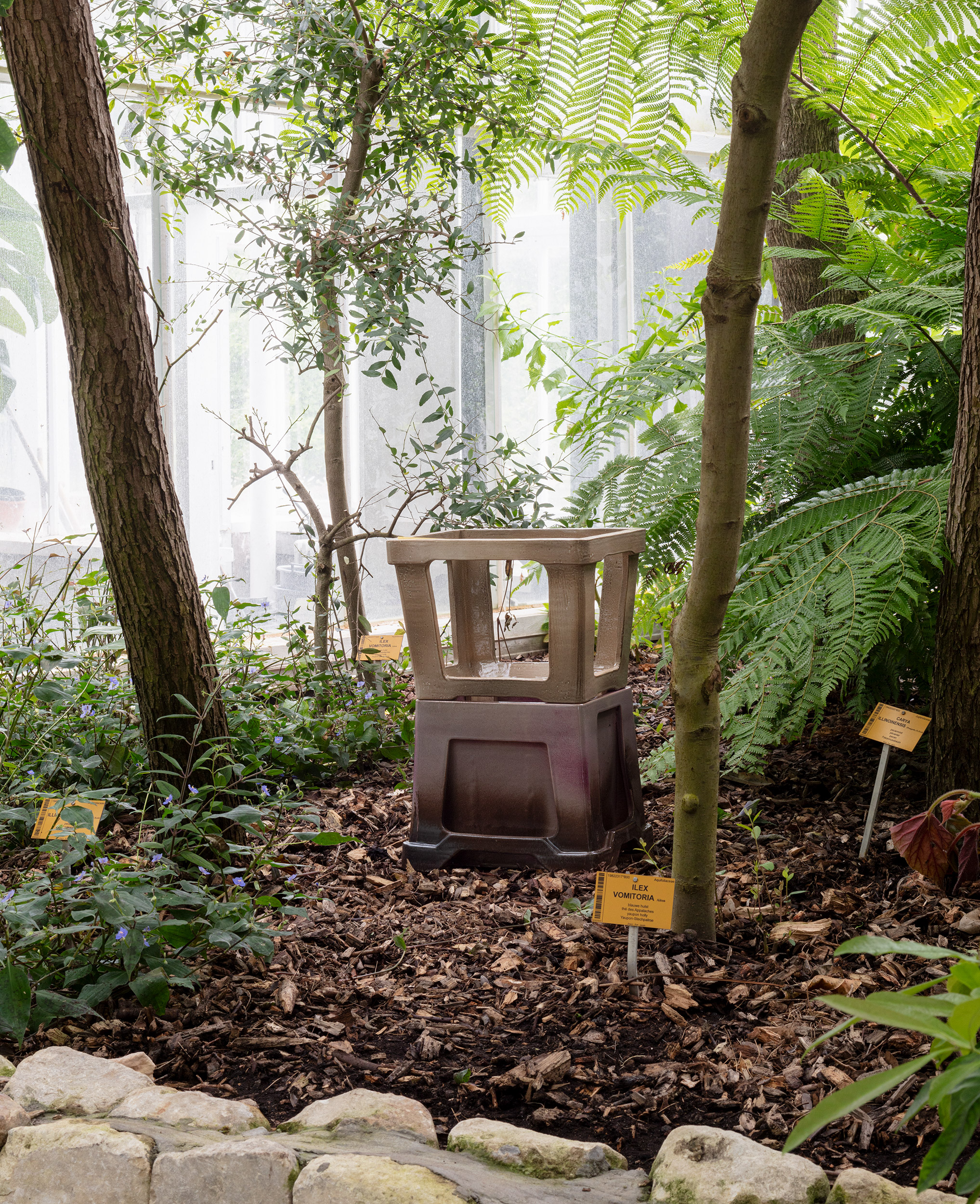
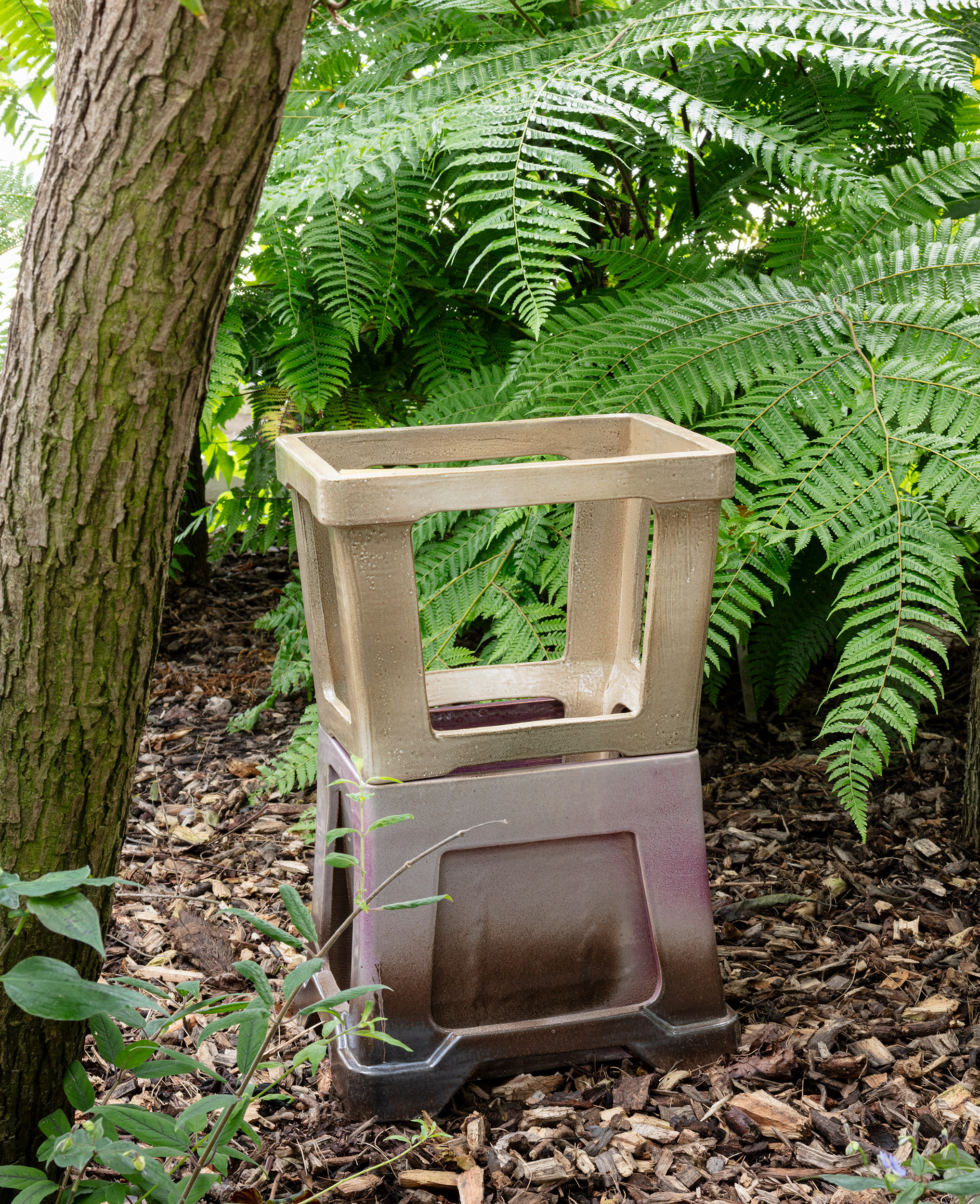

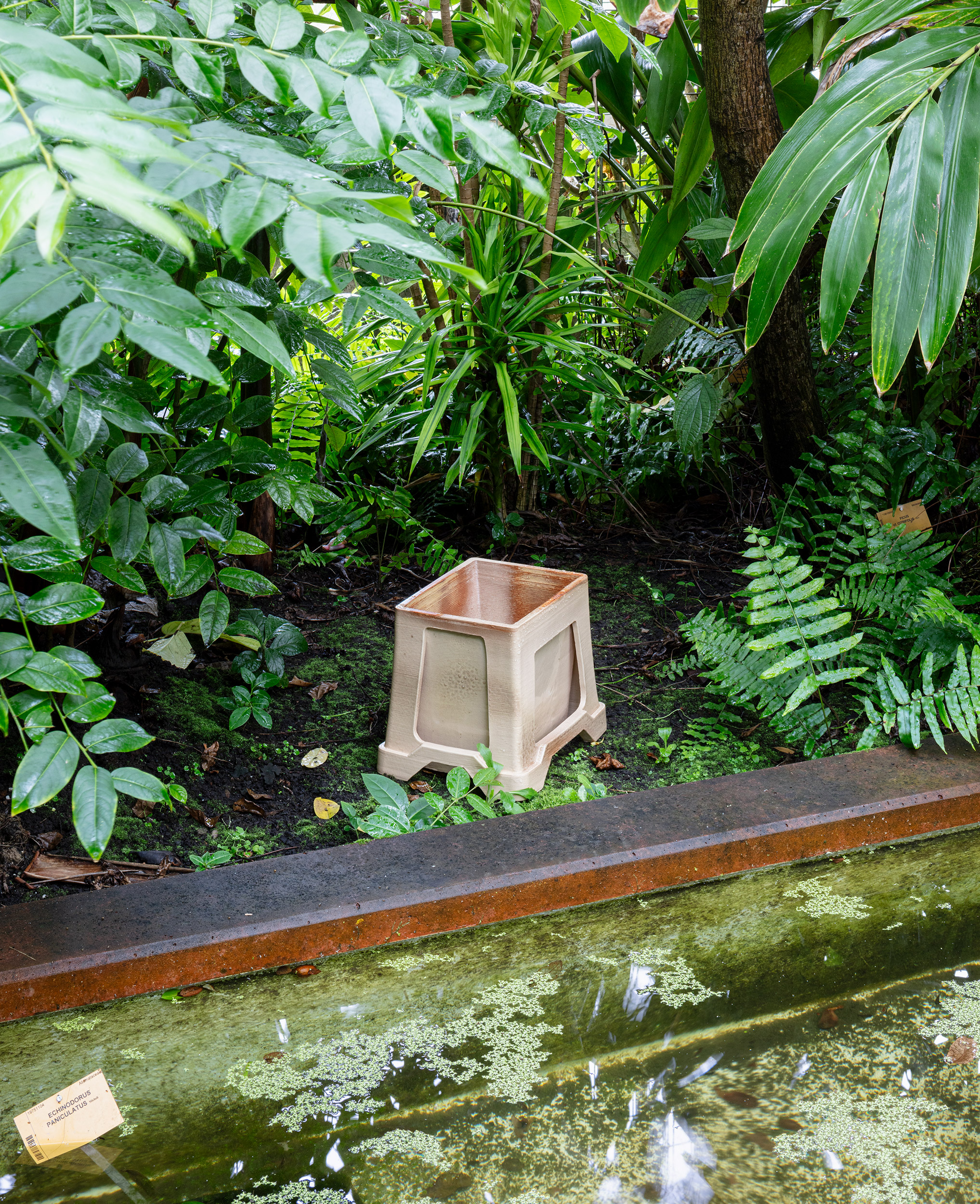


5. Bianca Baldi
at the Plant Palace, Savannah biomeHear her calendar system a year of thirteen months, 2025
Sound installation
In the centre of the Plant Palace greenhouse complex, the savannah biome houses a Ficus sycomorus, or sycamore fig tree. Native to Africa, south of the Sahel and north of the Tropic of Capricorn, this species can grow up to twenty metres tall in the wild, forming a dense, rounded crown of spreading branches. In the greenhouse, however, the tree remains relatively small and delicate.
Bianca Baldi’s family album bears witness to the migration journey that brought her family from Italy to South Africa, including photographs from her grandfather’s military deployment in Ethiopia. In one of these images, Baldi encountered a lush sycamore fig tree, which became the central figure of her research and the starting point for her film Hear her calendar system a year of thirteen months currently on view in the exhibition Magical Realism at WIELS. In this film, the tree is imagined as a more-than-human witness to cycles of time, resistance, and regeneration. A poem, interpreted by South African singer Gabi Motuba, accompanies a visual registration, a scan of a sycamore fig in Ethiopia – the only country in the world that uses a thirteen-month calendar system – reflecting on colonial histories of land exploitation while gesturing toward future imaginaries.
As an extension of the film in WIELS, an audio work echoes through the savannah greenhouse in dedication to the sycamore fig tree growing within it, weaving together melodies sung by Gabi Motuba with contemporary field recordings from the tree’s native environment.


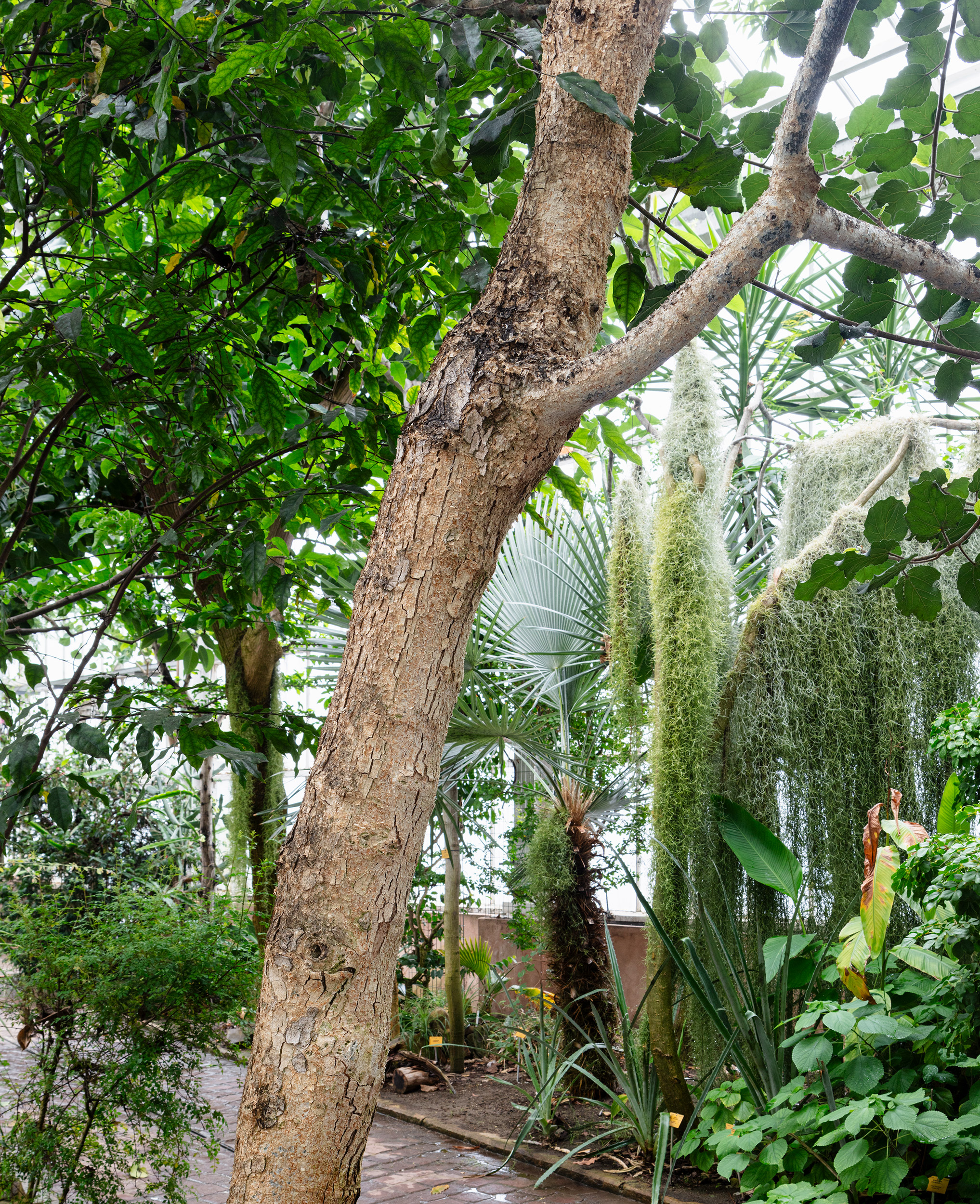

6. Gabi Dao
at the Hunting PavilionSweet Blood in Stagnant Waters, 2025
Video installation, 27’00
In the Hunting Pavilion, one of the follies which marks the grounds of Plantentuin Meise, Gabi Dao presents the film installation Sweet Blood in Stagnant Waters. This work was partially filmed in the botanical gardens, with key locations such as the Victoria greenhouse just beyond the view from the pavilion.
Drawing inspiration from science-fiction, fantasy and body horror, the film focuses on the figure of the mosquito, drawing on research Dao undertook into the Rubiaceae plant family at Meise, and the cinchona species known for producing a key ingredient in the malaria vaccine. Three cyborg protagonists, referred to as Angels, have left Earth to make a new home on a proxy planet. There, they are haunted by a human-mosquito mutant, the unborn child of the character Mary who follows them through semi-recognisable, dreamlike spatial landscapes, steeped in histories of colonialism, resource extraction and industry. Scenes move through a former cement factory to verdant botanical spaces, from laboratory to archive to bedroom.
Across these settings, the relationships between the characters unfold through dialogues which gesture to the porousness of the intimate, queer exchanges that humans and more-than-humans can have between each other and their environments. Against unsettling backdrops which fragment across multiple realities and macro-cinematographic images, moments of kinship and belonging emerge through the pursuit of optimism in the face of crises and alienation.





7. Josse Pyl
next to the Hunting PavilionOhhh…SPIT SMACK CHEW REPEAT!, 2025
Glazed porcelain
As you walk between the Hunting Pavilion and the Balat Greenhouse, hundreds of brightly coloured molars emerge from the grassy slopes. These porcelain pieces make up the large-scale installation Ohhh… SPIT SMACK CHEW REPEAT! by Josse Pyl. He primarily works with drawing and sculpture, exploring the origins of language and symbols. Motifs such as molars, teeth, and tongues point to the body as the physical site where language takes form – where sound is shaped and meaning begins.
The hundreds of teeth together sketch the outline of a falling figure, drawn in a single continuous line. This wriggling, childlike visual language evokes the unshaped, expressive way children experience speech and language, rich in confusion and unshaped by conventions. Following the figure’s line, punctuation marks emerge connecting the body to the mouth (almost like intestines), illustrating a scream as one of the most elemental forms of expression.
At the same time, the composition recalls a primal gesture: tracing the outline of a body as an early form of writing and giving meaning. Yet the absence of the body casts an unsettling shadow, much like the molars, now detached from the mouth.
The title captures these instinctive acts of language before structure fully emerges. As you read it aloud, you become aware of the physical intimacy of your mouth, as sounds turn into gestures and unfold in impulsive repetition, gradually losing their meaning. Between the 3rd and 14th September, Ohhh… SPIT SMACK CHEW REPEAT! will partially relocate to Botanique in Brussels for the second chapter of Publiek Park.





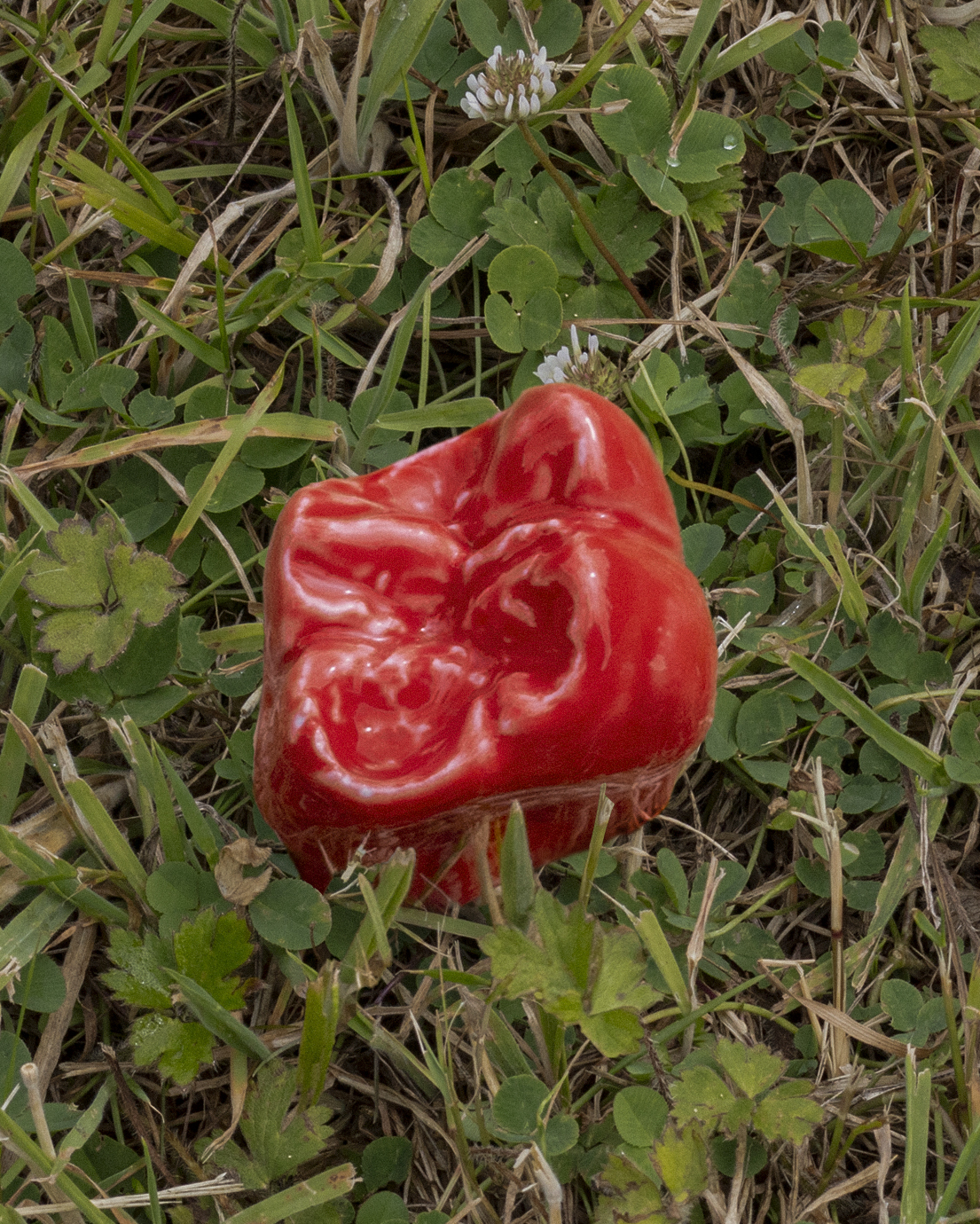


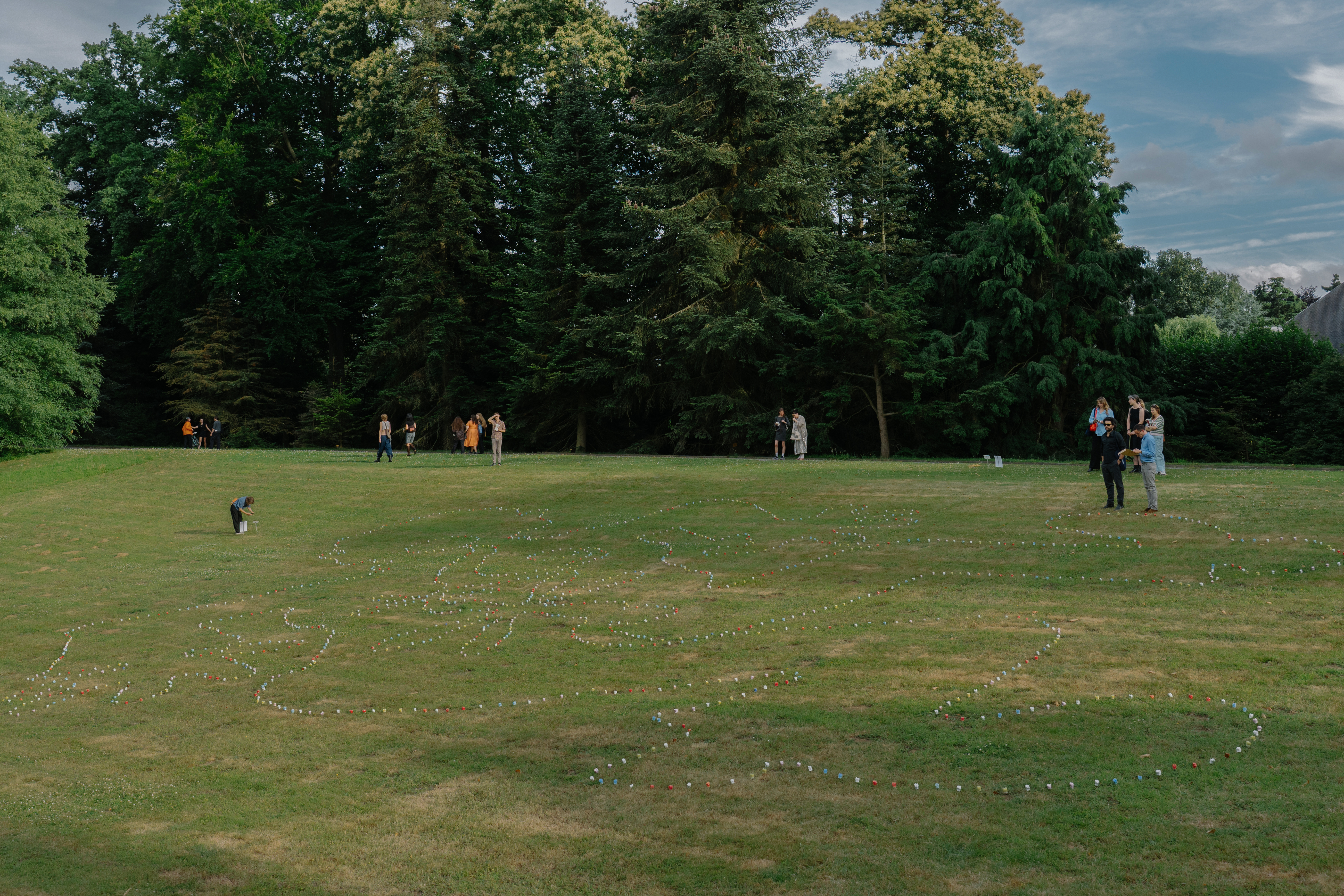
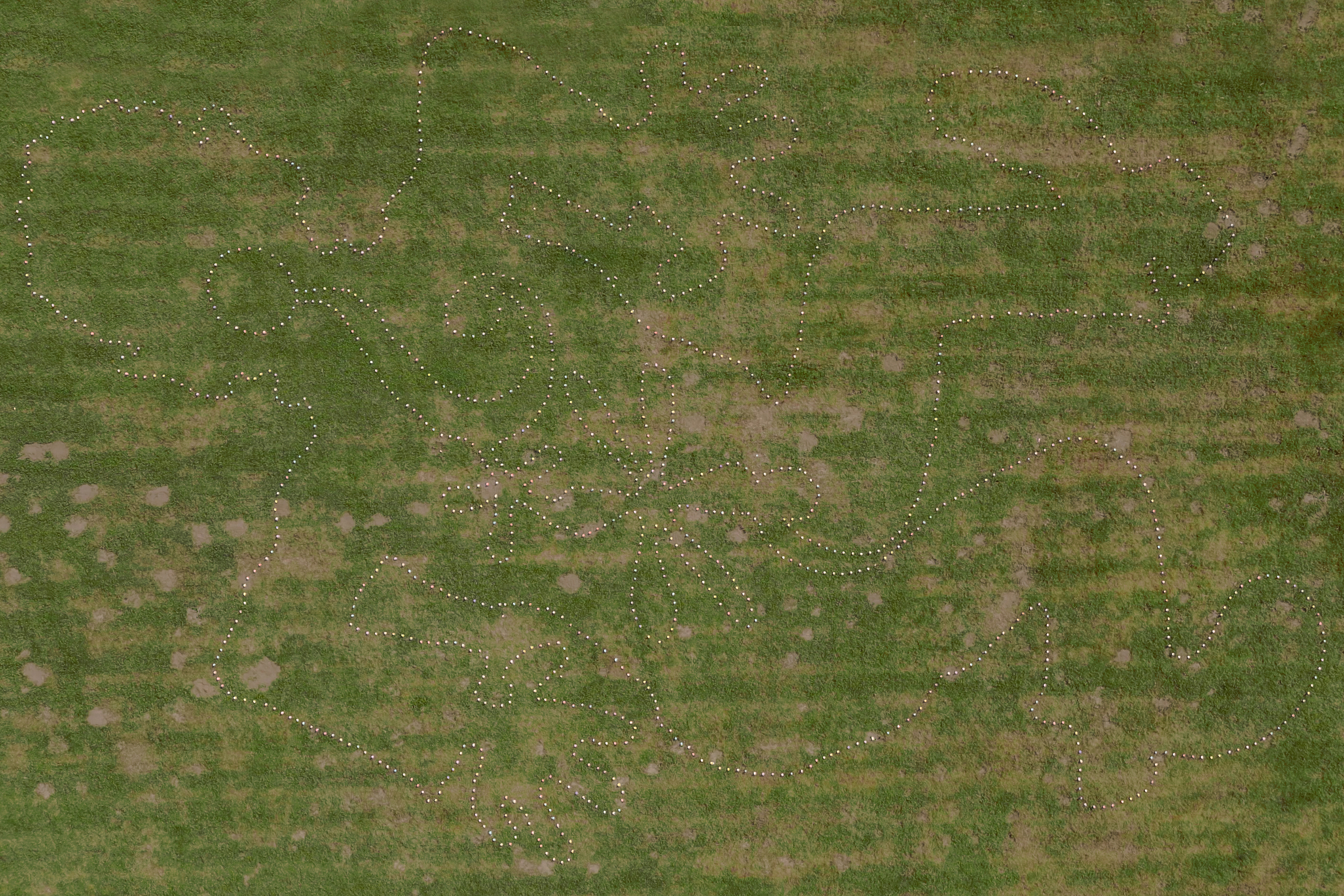
8. Elise El Yousfi
at the Dahlgren ArboretumWind Regards, Blind Regards, 2024/2025
Steel, glazed ceramic, ash, baby powder, steel beads sourced in Morocco
In the Dahlgren Arboretum, the sculptural ensemble by Elise El Yousfi stands amidst a collection of woody flowering plants. Four kinetic sculptures, with elements that rotate in the wind, recall the forms of plants as much as they do street lanterns, baby rattles, or folkloric instruments. Combined with steel beads sourced in Morocco, where her father's childhood home is located, the spheres attached to the metal arms produce sound. For El Yousfi, this sound echoes the experience of hearing a foreign language: an abstraction that arises when speech resists signification.
These objects are designed to evoke a sense of nostalgia and familiarity, as if returning to a space that precedes language and storytelling – the field of the unconscious and the visual logic of dreams. The artist’s precise and repetitive use of materials such as ceramics, lace, drawing, and baby powder forms a material vocabulary that, like language in poetry, unfolds in new constellations with each installation. In her practice, writing is the point of departure, echoing personal memories into a visual language both intimately and universally resonant.
While integrating poetic references to childhood, Elise El Yousfi’s works are created to evoke a sense of playfulness. Inspired in part by playgrounds, her sculptures invite visitors to engage, to explore them not only visually but also through touch, scent, and sound. The location of the Dahlgren Arboretum references the botanical classification system of the same name – a modern taxonomy that organises trees and shrubs into families. Similarly, El Yousfi’s work seeks to reconnect with the histories of her own family tree, tracing roots across geographic distance.





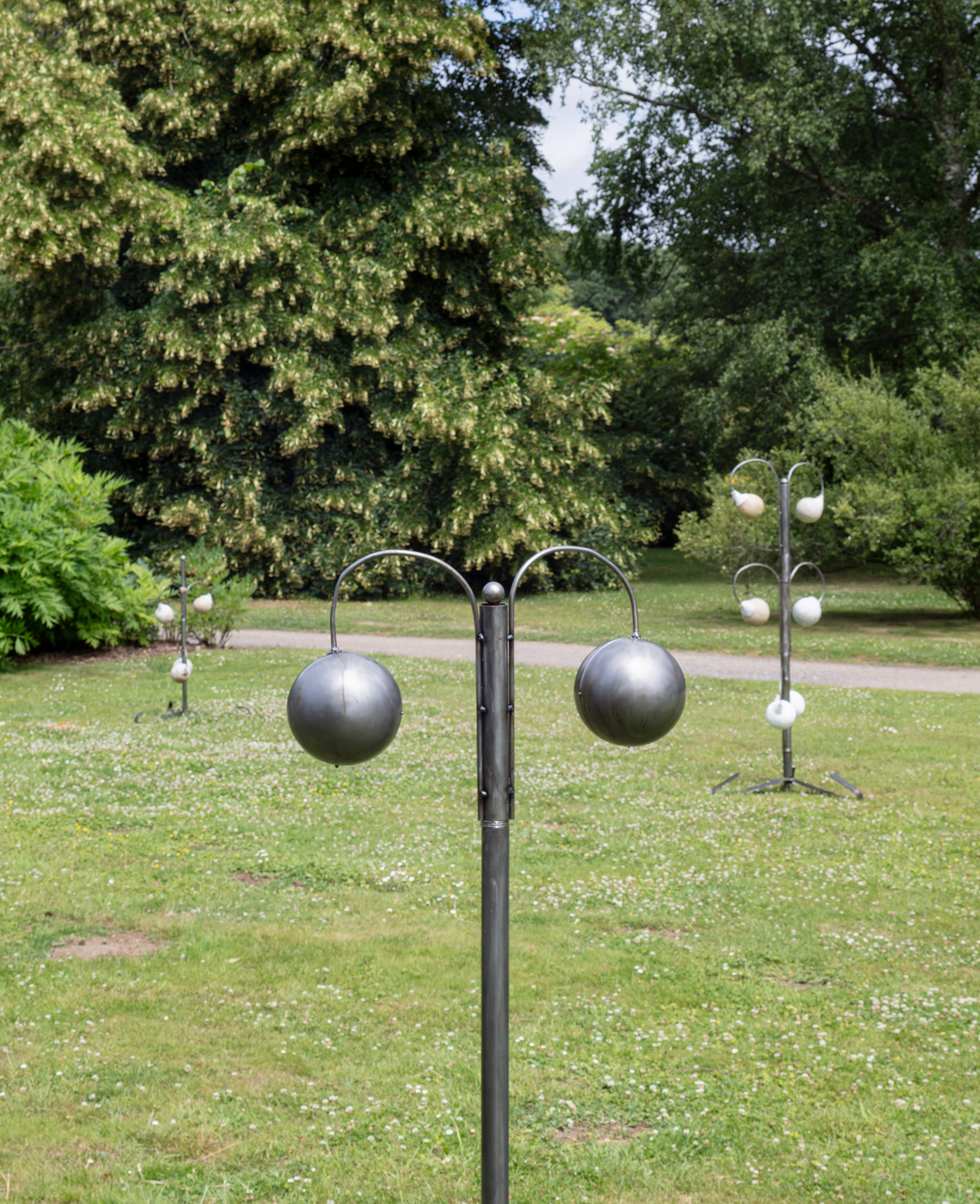


9. Myrthe van der Mark
at the Victoria GreenhouseSein Vater ist die Sonne, und seine Mutter ist der Mond. Der Wind trug es in seinem Bauche, und seine Amme ist die Erde, 2025
Series of four St. John’s Wort preparations, vase in glass by Serax found at Rotor Deconstruction
her phone reading: the moon in June falls mainly on the spoon, 2025
WALA Solum Öl, Hermès Terre d’Hermès
not for ourselves alone, 2025
Audio, recordings of St. John's songs sung by children from the Steiner School in Brussels (Sint-Janskruidlaan) are played through speakers
Myrthe van der Mark’s installation unfolds within the historic Victoria Greenhouse, or Balatkas – one of the most emblematic structures of the Meise Botanic Garden. Designed in 1854 by Alphonse Balat, court architect to Leopold II, the ornate octagonal glasshouse was originally built for the Brussels zoo. In 1878, it was relocated to the Jardin Botanique to cultivate Victoria amazonica, the giant tropical water lily sustained by a heated basin. Since 1941, the greenhouse has stood in Meise as a testament to nineteenth-century botanical architecture.
Myrthe van der Mark’s installation draws on hermetic traditions and the anthroposophic teachings of Rudolf Steiner – principles she was raised with as a child. Publiek Park opens during a symbolic moment: the birthday of her late father and the week of Saint John’s Eve, a solstice celebration associated with purification and transition. Marking both the birth and name day of John the Baptist, it is a time when light and warmth reaches its peak on one of the longest days of the year.
An octagonal plexiglass platform, mirroring the dimensions of the crown window above, presents four preparations of Saint John’s Wort, a healing plant that thrives in the medicinal garden beside the Balatkas. Salve, soap, infusion, and watercolour – distilled by the artist from her own harvest – are contained in anthropomorphic vases, prepared with beeswax and honey from the Plantentuin’s beekeeper. These four vessels serve as evocations of the installation’s title. Its father is the Sun, its mother the Moon. The Wind carried it in its belly, its nurse is the Earth is a central passage from the Tabula Smaragdina, a foundational alchemical text attributed to Hermes Trismegistus which deeply influenced Steiner’s cosmology. In the medieval garden of the Plantentuin, Van der Mark planted eight Saint John’s Wort plants in an octagonal formation, encircling four myrtle shrubs at the center as an echo to this installation.
Saint John’s Eve, central in Steiner education, is a festive gathering of music, bonfires, and flower wreaths, marking the school year’s end. For this work, the artist collaborated with the children from the Steiner school in Brussels, aptly located on Saint John’s Wort Street, to sing solstice songs in multiple languages. Their recording, Non nobis solum (“not for ourselves alone”), performed at the exhibition opening, now resonates continuously within the greenhouse as the days begin to shorten.
The windows are embalmed with Solum oil,used by the artist to anoint her father’s feet in his final days, and scented with Terre d’Hermès (Earth of Hermes). The Latin word "solum" means soil, but also translates to alone and sole. In botanical terms, it refers to the vital layer of earth that supports life. Solum oil is produced by the German company WALA. Deeply influenced by the teachings of Rudolf Steiner, its name stands for Wärme (Warmth), Asche (Ash), Licht (Light), and again Asche-a cyclical sequence evoking transformation. The perfume’s name alludes to Hermes, the Greek god of commerce and communication, who is also a figure of transition, as he moves freely between worlds. More than a messenger, he guides souls to the underworld. This crossing of thresholds – between child and parent, day and night, life and death, matter and soul – echoes through the work’s gestures of sound, scent, and presence.
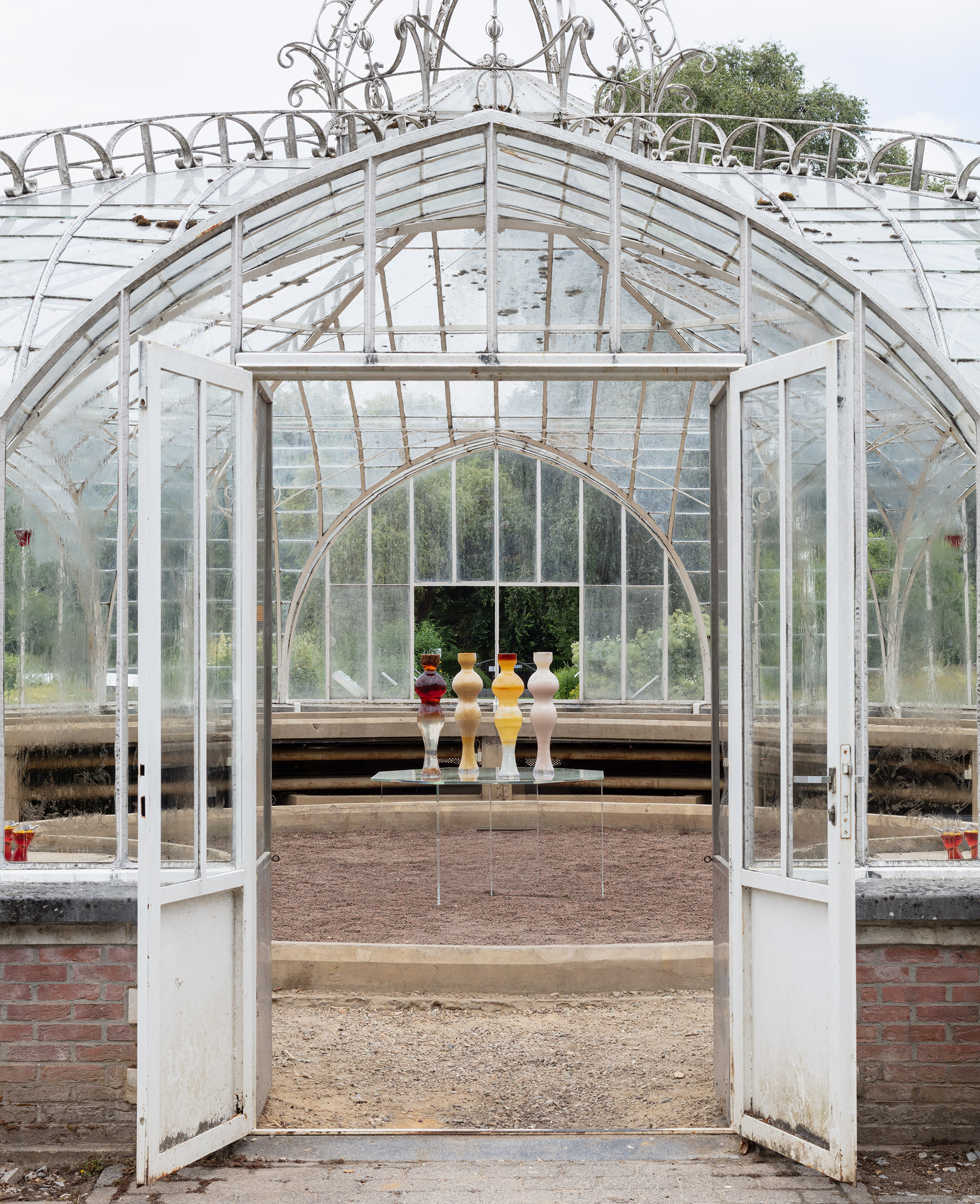
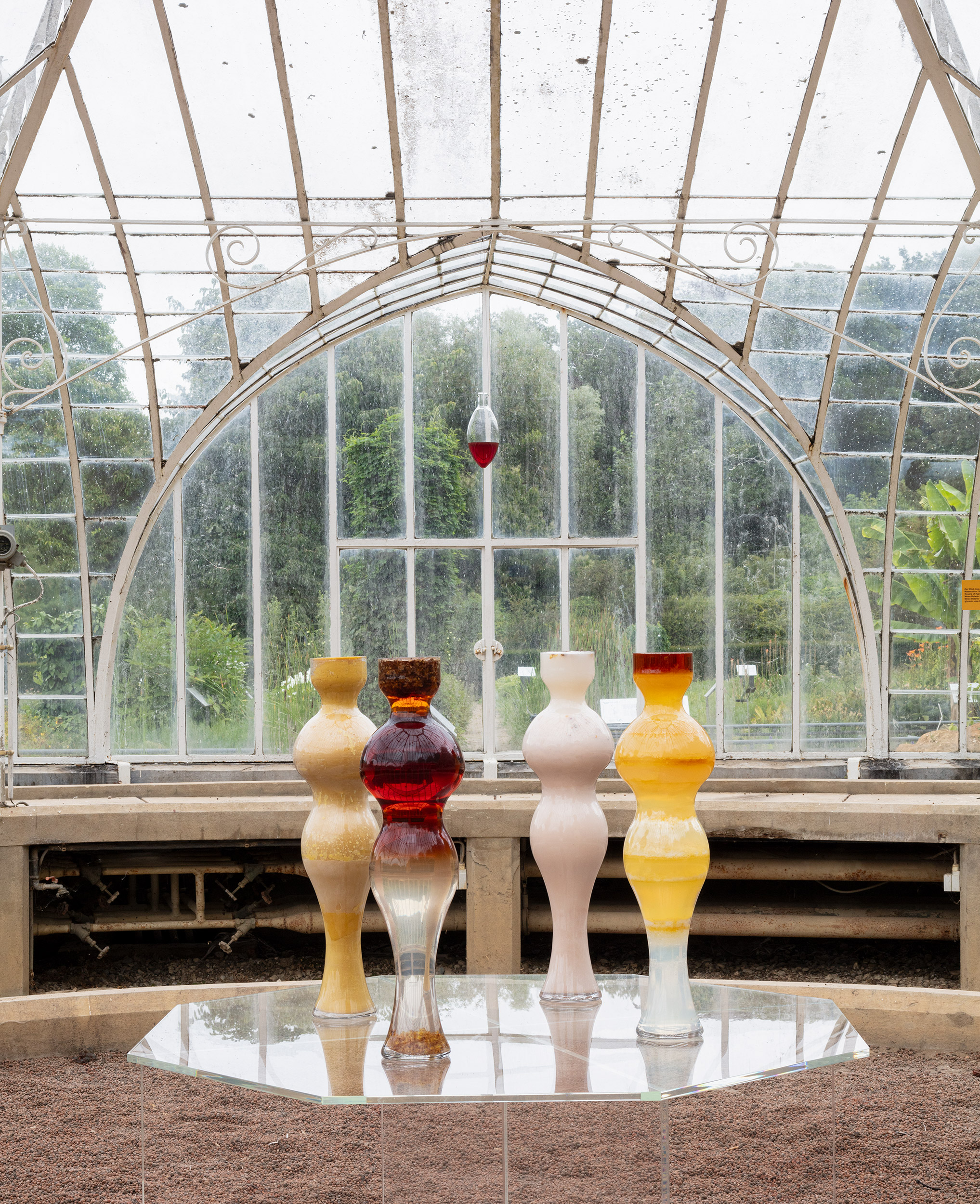
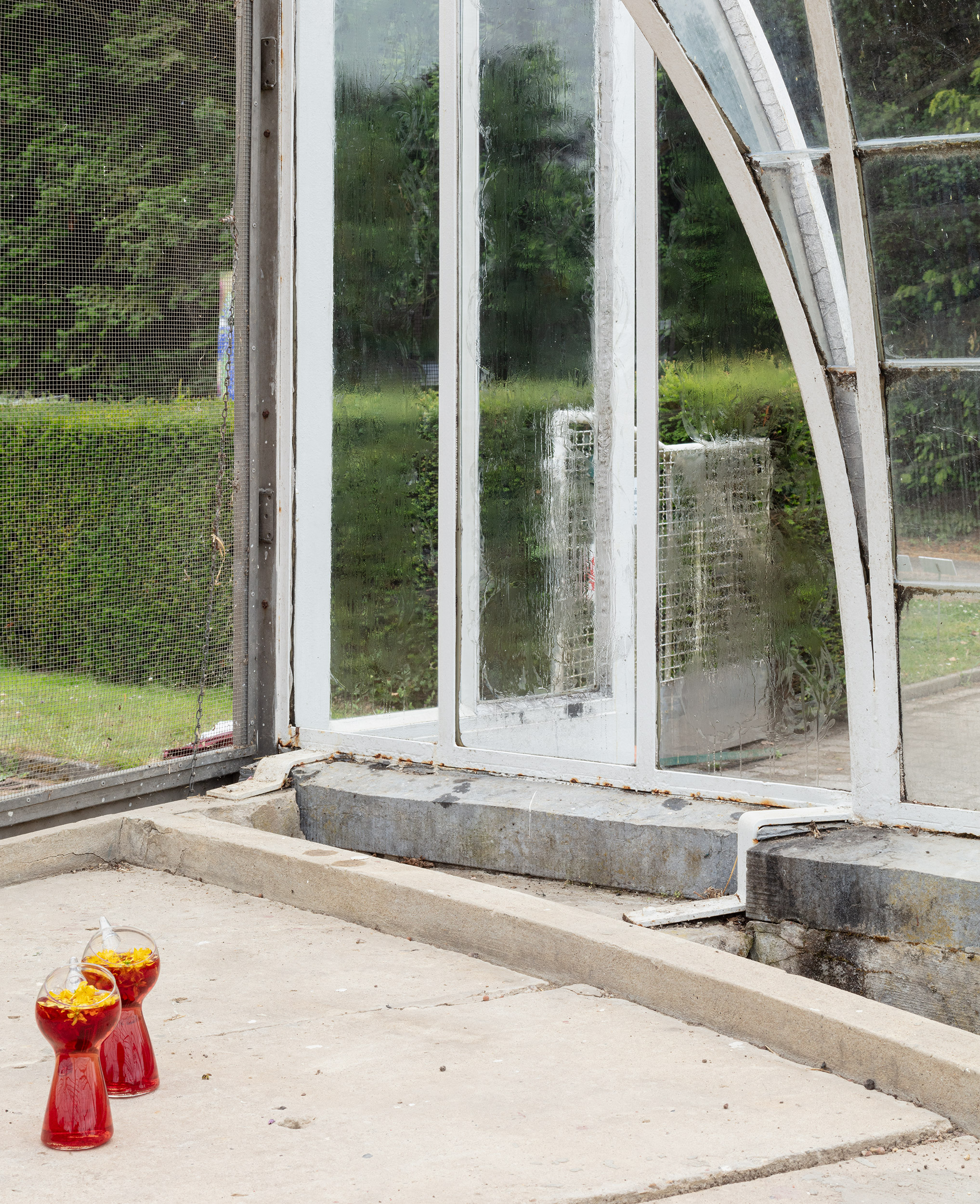










10. Jura Shust
at the WOODlabLeaving an Annual Growth at the Top: Succession, 2024
Spruce trunk, resin, stainless steel
Neophyte III: On the Eve of the Shortest Night, 2023
Ultra HD Video, 14’04”
Two or Three Girths Wide, 2024
Spruce wood, resin, stainless steel
Coniferous Succession, 2023
Stereo sound, 9’06”
The works of Jura Shust, comprising sculptures, video, and audio pieces, are situated in and around the WOODlab. The lab tells the story of wood as a material, emphasising its utilitarian and technological uses. It is based on the collection formerly exhibited at the Forestry Museum, once housed in the Botanique building in Brussels. Shust's artistic interventions, grounded in his research into indigenous ethnoreligious practices of Slavic peoples, overlay this educational display with an alternative narrative. His works activate symbolic and mythological modes of thinking, reviving an eco-spiritual relationship with nature while rethinking the idea of technological progress.
Among the educational screens within the exhibition, the video Neophyte III: On the Eve of the Shortest Night revisits the traditional Slavic Kupala ceremony marking the summer solstice, which takes place in the week of Publiek Park’s opening. The video depicts eight Belarusian refugees engaging in a symbolic procession near the Belarusian-Polish border. According to Slavic mythology, on Kupala night, animals, trees, and herbs gain the power of speech and movement, as fire and water become forces of purification and renewal. The video portrays ritual as an ancient form of environmental communication, weaving contemporary geopolitical tensions into the symbolic fabric of this midsummer rite of passage. As the exhibition continues, the days will shorten in the journey towards the winter solstice, with the film symbolically marking its starting point.
As a reference to the Slavic concept of a sacred grove, which can be considered an early form of an Eco-reserve, Leaving an Annual Growth at the Top II, captures a spruce trunk from the oldest European forest, Białowieża. The tree is encapsulated in resin and locked into a metal slot. The ancient tradition of ritualistic branch cutting is rooted in the connection between ancestors and descendants, where receivers can read the message encoded in a living tree.
The further sculpture refers to ancient burial practices, where a tree would be used as a vessel for a dead body. Two or Three Girths Wide consists of three pine wood slabs with V-shaped incisions, created in the process of resin extraction from living trees. The excessive markings on these panels suggest that the tree has died during the harvesting process.
Outside the WOODlab, at the cross-section of a sequoia tree over a thousand years old, is the audio work Coniferous Succession. It compiles excerpts from various ethnographic texts that study human-tree relations in Northern and Eastern Europe while referencing the Slavic spirit of the forest, known as Leshy, which reveals itself with a human voice.
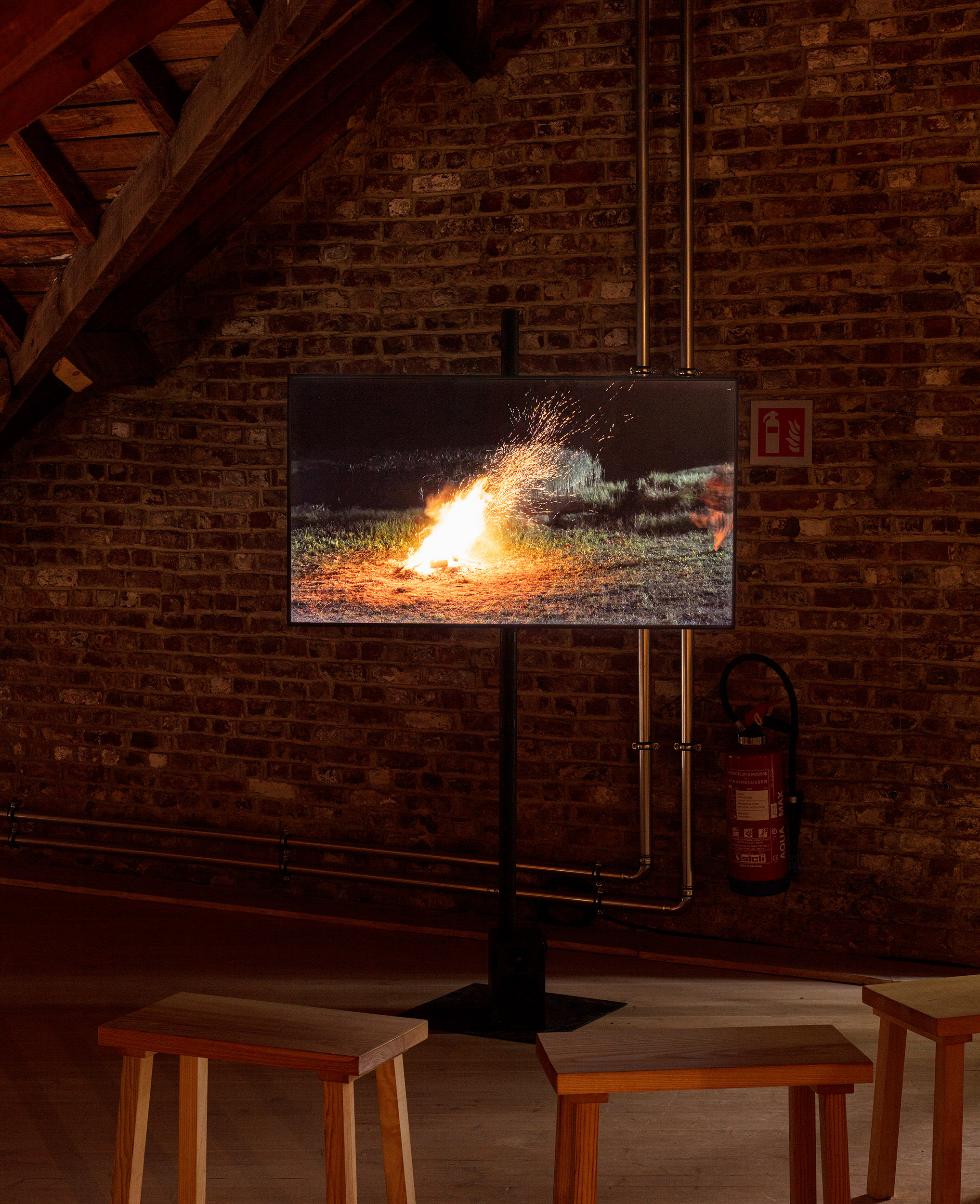





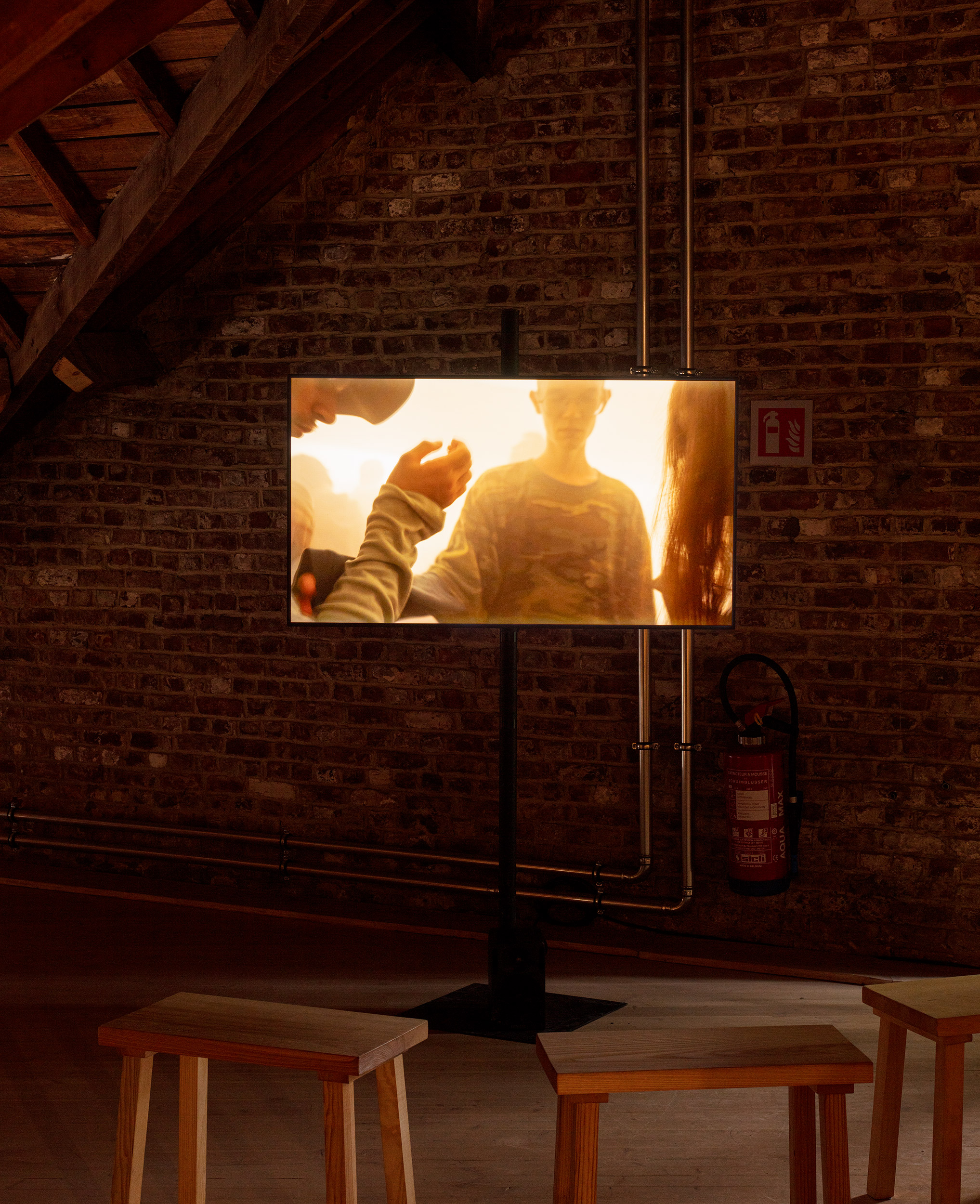
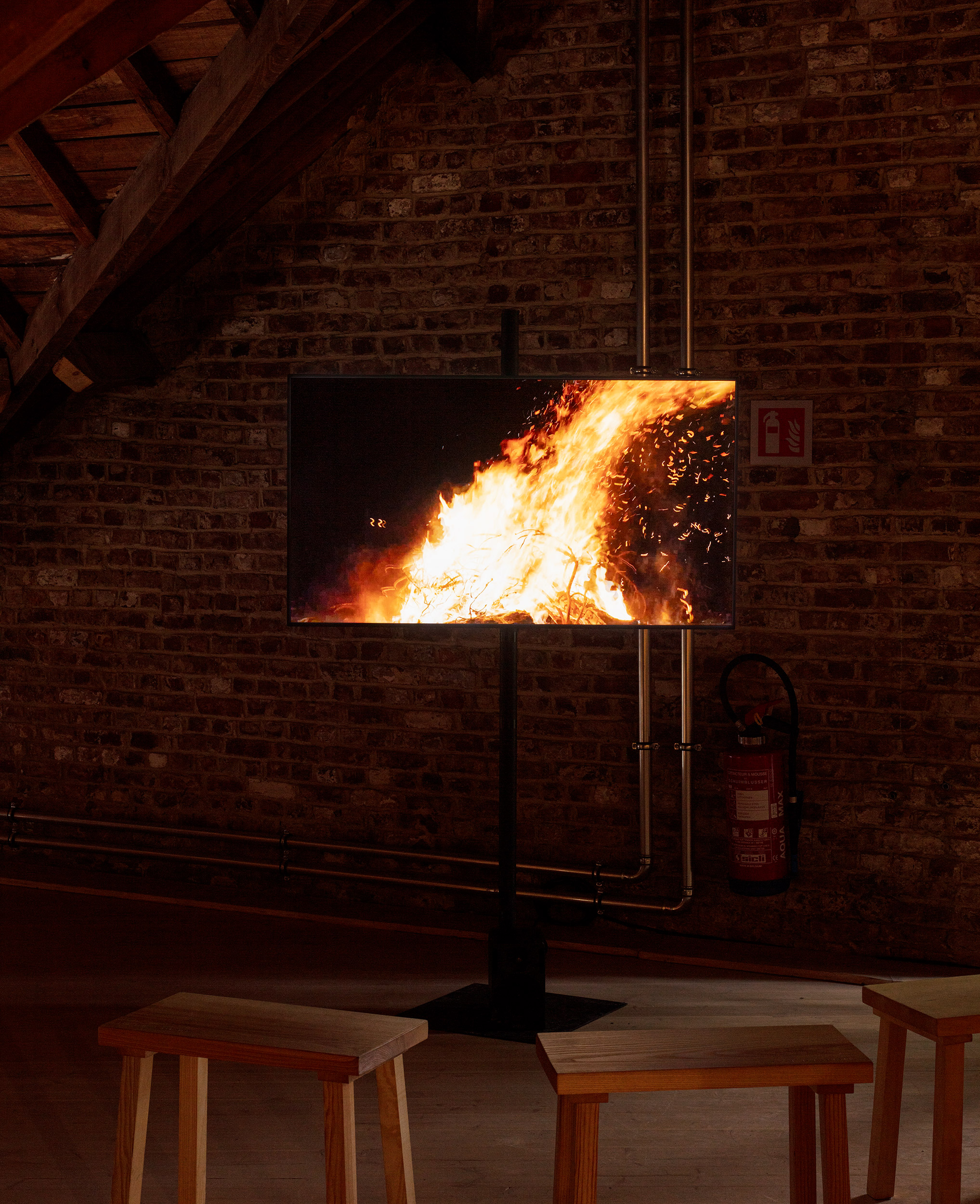

11. Helen Weber & Isa Schieche
at the Friendship TempleGay by Nature, 2025
Film installation, 2K Video, 21'30", objects made out of spruce, nutwood, ash, hazelnut, poplar and linen
At the Friendship Temple, a pavilion tucked away in the greenery of the botanic garden, Isa Schieche and Helen Weber present a film installation, Gay by Nature, parts of which were filmed in Plantentuin Meise and Jardin Botanique de Bruxelles.
Set in the near future, the film imagines a world where the rise of right-wing and nationalist forces has led to a fascist regime. Echoing the Nazi regime a century earlier, this new authority conducts secret experiments on humans. In an attempt to create a superhuman, they combine the DNA of big cats and humans. The experiments, however, result in an unexpected failure for the fascist elite – all test subjects turn out to be large, peace-loving lesbians. While the programme is halted on moral grounds, citing the need to protect traditional family values, the remaining subjects are confined to a free-roaming enclosure, living their lives for the amusement of visitors.
Incorporating musical elements, Gay by Nature is a contemporary interpretation of the Heimatfilm – a genre of German-language cinema popular from the late 1940s to the 1960s, known for its sentimental stories set in idyllic rural landscapes, and its focus on themes such as home, tradition, and moral values.
For some, the Friendship Temple may recall the salon of the same name hosted by Natalie Clifford Barney in early twentieth-century Paris, frequented by leading figures of the Parisian modernist literary scene. Echoing the storyline of Schieche and Weber’s film, Barney, who often published under the nickname l’Amazone, lived openly as a lesbian and wrote extensively about feminism and pacifism. Beyond this historical parallel, the film’s dystopian narrative also resonates with episodes from Belgium’s colonial past. The presence of violent control of “the other” showed itself as recently as Expo ’58 taking place in the same year as the inauguration of Plantentuin Meise.






